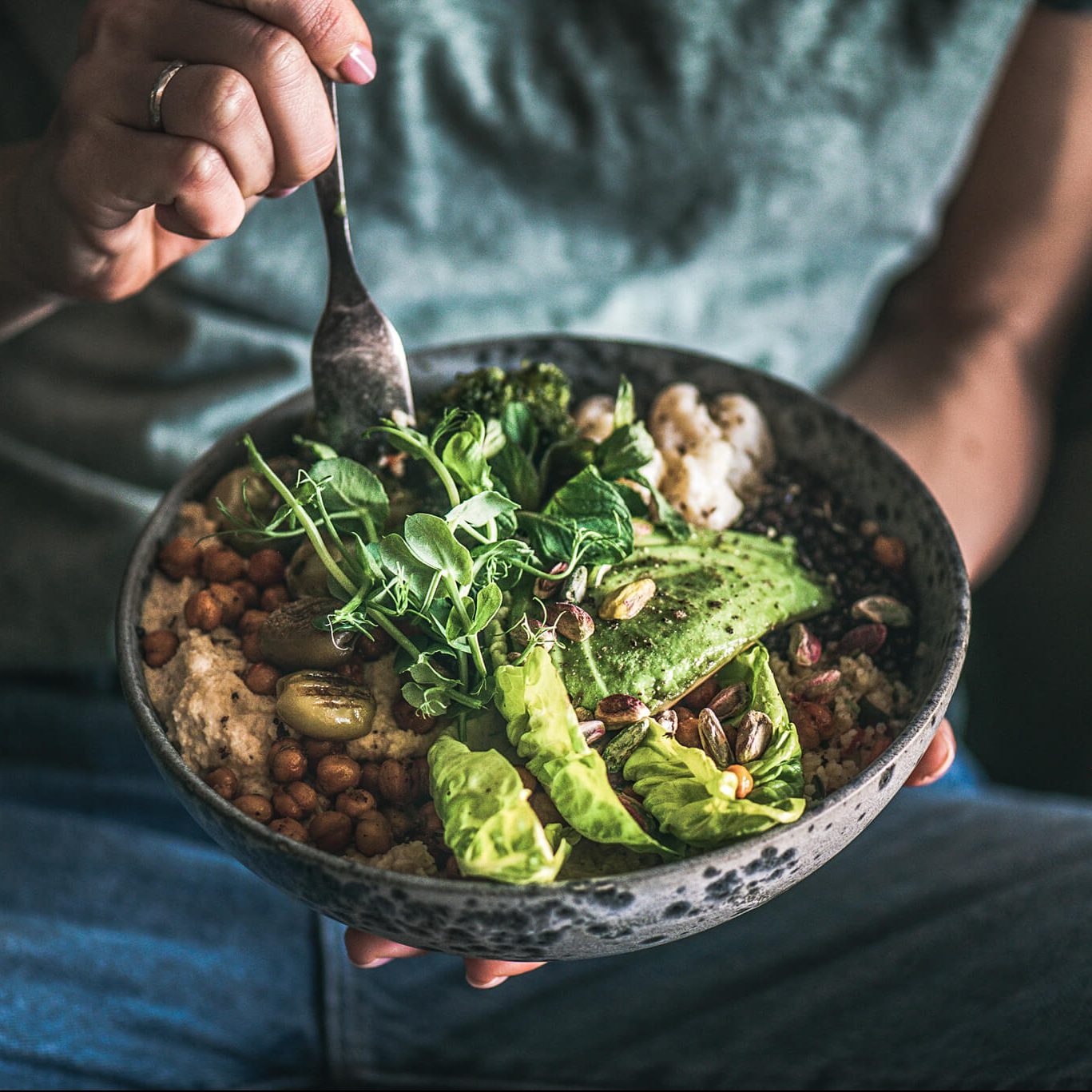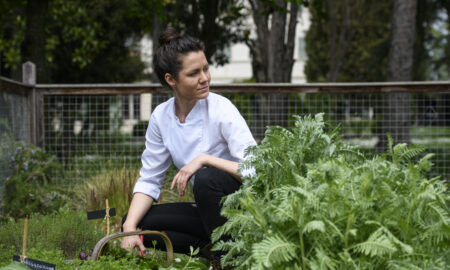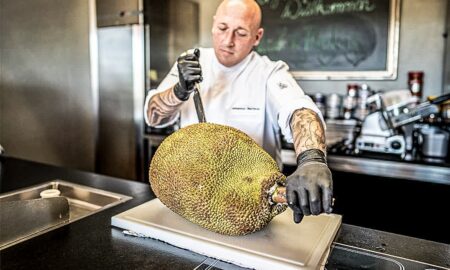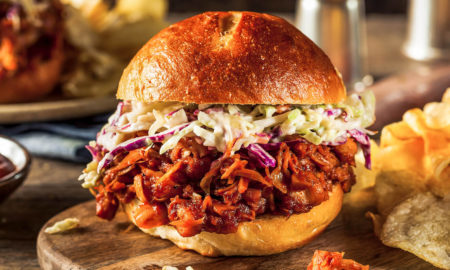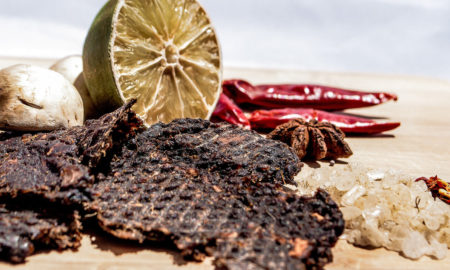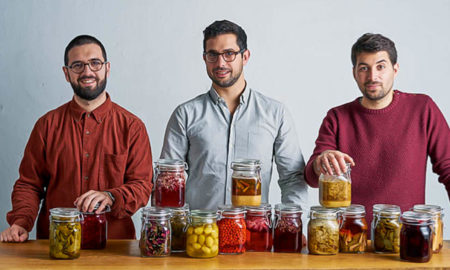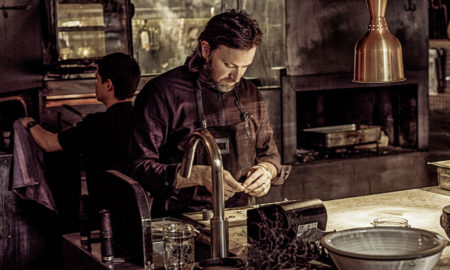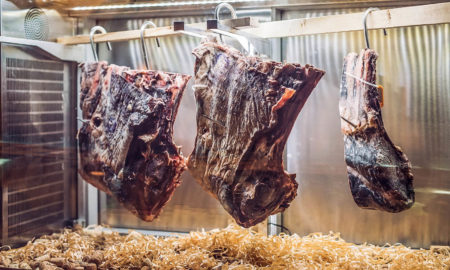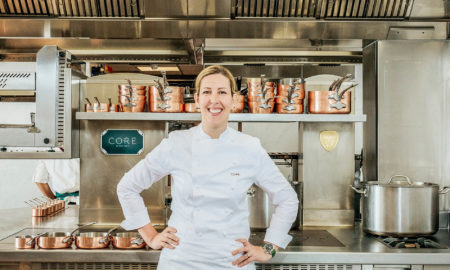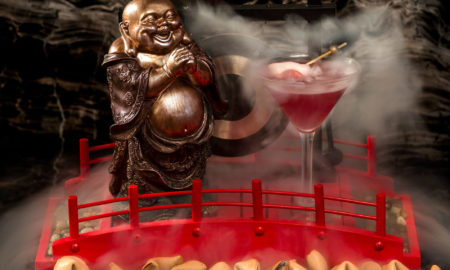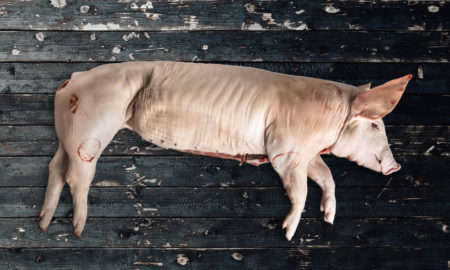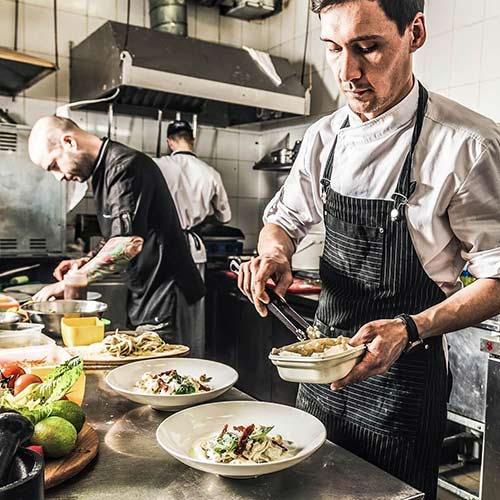
- Hybrid food: how croissant donuts and sushi burritos are changing gastronomy
The idea behind it is as simple as it is ingenious: Two culinary products are merged to become a completely new...
Kim KopackaApril 19, 2024 - Hygiene with added value: What is HACCP and how is it best implemented?
For many, HACCP sounds like something of a nuisance – but the new technological achievements in particular show that The hygiene...
Lucas PalmApril 12, 2024 - Andreas Gugumuck: Vineyard snails as a sustainable delicacy and source of protein
Delicatessen and healthy sustainable protein source: Austrian snail breeder Andreas Gugumuck is very concerned about sustainable agriculture – and that's why...
Hannes KropikApril 4, 2024 - Antonio Bachour: His recipe is passion
Antonio Bachour is undoubtedly one of the best pastry chefs in the world. What makes him an excellent baker in the...
Michi ReicheltMarch 27, 2024 - A Casa do Porco: Nose-to-tail for everyone!
At A Casa do Porco in São Paulo nose-to-tail, i.e. the concept of whole animal use, is more than just put...
Lucas PalmMarch 21, 2024 - Rehan Uddin: This is how smart Asian cuisine can be
Rehan Uddin is the figurehead of a new generation of Asian-inspired chefs. At his restaurant Indi-Yang, he shows how fast, efficient...
Lucas PalmMarch 14, 2024
Further Posts
- Hybrid food: how croissant donuts and sushi burritos are changing gastronomy
The idea behind it is as simple as it is ingenious: Two culinary products are merged to become a completely new...
Food TrendsKim KopackaApril 19, 2024 - Hygiene with added value: What is HACCP and how is it best implemented?
For many, HACCP sounds like something of a nuisance – but the new technological achievements in particular show that The hygiene...
Food ManagementLucas PalmApril 12, 2024 - Andreas Gugumuck: Vineyard snails as a sustainable delicacy and source of protein
Delicatessen and healthy sustainable protein source: Austrian snail breeder Andreas Gugumuck is very concerned about sustainable agriculture – and that's why...
Food PeopleHannes KropikApril 4, 2024 - Antonio Bachour: His recipe is passion
Antonio Bachour is undoubtedly one of the best pastry chefs in the world. What makes him an excellent baker in the...
Food PeopleMichi ReicheltMarch 27, 2024 - A Casa do Porco: Nose-to-tail for everyone!
At A Casa do Porco in São Paulo nose-to-tail, i.e. the concept of whole animal use, is more than just put...
Food PeopleLucas PalmMarch 21, 2024
- Gastro trade fairs 2024: These are the must-attend events for all chefs and restaurateurs this year!
Nowhere else offers more valuable contacts, nor provides more inspiration in one go – and no other place attracts more industry superstars than the world's most successful gastronomy trade fairs. Discover in KTCHNrebel which ones are taking place in 2024 and...
- The microwave re-invented: See what the new iHexagon from RATIONAL can do
In the KTCHNrebel interview, the Executive Board Member for Marketing and Sales and the RATIONAL Head of Development discuss the challenge of microwaves for professional kitchens. Food prepared quickly can't taste good?
- What’s coming up with the catering industry in 2024? These are the key trends
From New Work to planet-friendly plant-based food and snackification: The catering industry is busy in 2024. Why this is good news in times of crisis – and what RATIONAL steamers have to do with it.
- Shared tables: How strangers become friends in restaurants
Shared tables are on trend: Time and again we read about how people no longer just share their culinary experiences in restaurants with good friends, but also consciously with strangers. The reasons and concepts for this are diverse.
- Automated restaurants: Will robots take over the kitchen now?
Employees shortages are everywhere, while robots are becoming ever more efficient and cost-effective. This trend is not only evident in industry, it's also increasingly taking hold in the gastronomy and foodservice sector. In the USA, an increasing number of automated restaurants...
- Daniel Humm: The secret of his three-star vegan cuisine
Three Michelin stars for vegan cuisine: Daniel Humm proved that this is possible in 2022 with his Eleven Madison Park. But how? And what does a school psychologist have to do with this?
- Too many cooks spoil the broth? Not if the kitchen is big enough
Gone are the days when everyone still drove to the office every day - welcome to the era of working from home and remote working. But what if there’s no room to work in the one-room apartment or hotel room or...
- Quality instead of junk: the street food trend
From premium döner kebabs to French tacos: Street food is a trend throughout Europe and indeed throughout the world, with high-quality offerings becoming increasingly popular. Junk is out. Quality is in.
- Adults only: No children in restaurants and hotels
Not too long ago, they were criticized as “child haters”: Restaurants that put a stop to the screaming and noise of children running around by imposing age restrictions. But now they’re totally on trend. Adults only is increasingly in demand in...
- Vincent Crepel: “My cuisine should send people on a journey.”
In Terre restaurant in Cork, Vincent Crepel has been awarded a star with French technique, Asian flavors and Irish ease.
- Signature dishes: The idea that changes everything
Just as a book can make writers world famous, chefs gain fame and recognition with their signature dishes. These five unique dishes not only have their chef’s individual signature, they've also written gourmet history.
- Cooking vegan without substitute products
Trust in vegetables rather than fake schnitzel. Top Indian chef Gaurav Bajaj clears up common vegan misconceptions and uses the flavors of his childhood, his closeness to nature and lessons learned from bœuf bourguignon in his vegan dishes.
- Chef Gordon Ramsay: The good, the bad and the star
Gordon Ramsay is one of the few star chefs who have been successful for decades. And this in spite of ongoing, major criticism of his behavior. Why do people really love this "bad boy" among chefs so much?
- The Christmas menu evolves: seven tips for festive success
Alex Rushmer of Vanderlyle offers top seven tips for how he made his restaurant’s Christmas menu – and additional festive offerings – work in changing times
- Ergonomics in the kitchen – how modern kitchen equipment supports employee health
Ergonomics is the science of designing humane working conditions. It encompasses a broad definition with as many forms as there are ways of implementing it. However, they all have common goals: healthier employees, greater productivity and financial advantages. So much for...
- Alex Atala: Brazil’s Jungle Messiah
Alex Atala is the master of Brazilian gastronomy. Like no other, he has linked it with the issues of sustainability, human rights and biodiversity – and given his country back a culinary culture that is now known throughout the world. How...
- Philipp Schmöller: How do you calculate costs correctly in gastronomy?
Correct costing in the gastronomy sector is challenging, but it's not just about numbers. Philipp Schmöller from Berggasthoff (mountain inn) Dreisessel proves just how much potential there is in a sparse menu and the right kitchen technology – curry sausage included....
- Food trend zero waste – on the plate instead of in the bin
Restaurant owners and businesses are developing exciting concepts to reduce food waste and garbage. Nevertheless, there is still a lot of room for improvement in the zero waste food trend, says trend researcher Hanni Rützler.
- Esben Holmboe Gang from Maaemo: Norway’s quiet culinary king
With his restaurant Maaemo, Esben Holmboe Gang has revolutionized Norway’s gastronomy and is bringing New Nordic Cuisine to the world. Here's why the quiet Dane still doesn't care much about being in the limelight – and needs limitations to be really...
- Artificial Intelligence – Potential and challenges in the professional kitchen
Artificial intelligence (AI) has lately been gaining a lot of traction in the hospitality industry. On the one hand, hoteliers and restaurateurs can offer an improved customer experience, partially automate processes and reduce costs. On the other hand, it can also...
- Slowing down with (restaurant interior) design
At Ukiyo in Munich, both body and mind can find peace thanks to the unique interior concept.
- This is the future of small caterers
The catering industry is undergoing a massive upheaval – and no one is really talking about it. Why is this the case? What is the decline of small caterers all about? And where is the catering industry heading in the next...
- Regenerative food – a solution for climate change?
Regenerative food is the latest food trend in the current Food Report 2024. It is perhaps also the most promising – including for the gastronomy industry. The focus here is not primarily on food, but rather on arable soils.
- Female connoisseurs: Sustainable and female – the taste of the future
For a long time, food service was a male-dominated industry. However, an increasing number of women are now fighting for their (well-deserved) place in gourmet kitchens, founding innovative start-ups or making a name for themselves as bartenders. But where is this...
- Local exotics: The goods are closer than you think
Behind the local exotics food trend are experimental farmers and start-ups who are growing and cultivating exotic food in places you don't expect. Climate change is making it possible – but also necessary. In the meantime, this food trend is gaining...
- Ebru Baybara Demir – Changing lives through gastronomy
Earlier this year Turkish chef Ebru Baybara Demir was named as the recipient of the prestigious Basque Culinary World Prize for her social and community-based work in her country.
- Chaotic opening deluxe? This is how to make every opening a success!
A lot can go wrong when opening a restaurant. But these are the five most common gastronomic mistakes that really need to be avoided at all costs. KTCHNrebel shows you how.
- Plant-based food: Meat or not meat, that is the question
According to a study by the University of Bonn, to continue feeding humanity in the future, we would have to reduce meat consumption by around 75% overall. However, the mainstream does not like the idea of completely doing without. But is...
- How artificial intelligence reduces food waste in the foodservice industry
Far too much food in the gastronomy industry still ends up in the trash. How artificial intelligence (AI) can drastically reduce food waste in the gastronomy industry - and thus also make money while saving the climate.
- The culinary giant from the Basque Country: Martín Berasategui
Martín Berasategui has been shaping Spain’s rise to a culinary world power for almost 50 years – and is breaking all records among Spain’s top chefs. Why he's nowhere near done – and why the youth today is the best culinary...
- 6 steps toward attracting and retaining kitchen employees
As labor woes continue, chefs share some of their strategies for keeping up staffing levels.
- Navigating allergens and dietary restrictions: tips for success in your restaurant
With legislation on food allergies tightening up around the world, what can hospitality businesses do to ensure compliance and customer satisfaction?
- The big smoke: how innovation is changing smoked cooking
Our love for smoke-cooked food remains unsated for many millennia. However, smoking food well conventionally can take years of experience. But now, new technology is ensuring that precision and consistency are part of a smokin’ hot combination for chefs.
- Supermarket gastronomy: A serious threat to restaurants?
Supermarkets are increasingly relying on gastronomy, especially in the USA. The aim is to turn shopping into an experience and an enjoyable way to pass the time. But how exactly? Last but not least, is this a threat to the restaurant...
- Sous vide: how innovation is enhancing a chef favorite
Called “the single greatest advancement in cooking technology in decades” by Heston Blumenthal, sous-vide cooking has become an essential mainstay in a modern’s chef's arsenal. Now, new technology is elevating the methods precision and consistency to new levels.
- Why good company restaurants are more important than ever before
The role of company restaurants has changed significantly due to the coronavirus pandemic. One question in particular was raised: Do we still need them? The answer is now clear: They are more important than ever. Why even the seemingly best among...
- Food courts: The new gastronomy paradise
Food courts are winning the hearts and palates of foodies all over the world. Why this phenomenon is expected to have a glorious future – and why overload is the ultimate appetizer.
- Multisensory influences – how sound and light influence taste
Anyone can describe what a particular food must look like to be perfect. For example, the lovely, deep green of broccoli or the crispy, not-too-thick crust of a loaf of bread. And yet, are we and our tastes really impartial when...
- Alexa for Hospitality – Revolutionizing the Hotel Industry
At first glance, it seems just like an inconspicuous speaker. At second glance too. Yet Alexa has long since conquered our living rooms. But she hasn't stopped there. Alexa for Hospitality and 'friends' are now also a major focus among hotels...
- School meals: We don’t eat for school, we eat to live
Hardly anything is as important in a child's development as nutrition. School meals in particular play an important role here – and thus also teaching staff, politicians and manufacturers. Innovative approaches, especially with regard to raising awareness, are more in demand...
- Is high-end convenience the recipe for the future success of gastronomy?
Lots of time, lots of onion: Gaurav Bajaj and Kiran Mazumdar believe they have found the formula for success for high-end convenience. Why this is immensely important for the future of gastronomy – and why it doesn't need flavor enhancers, preservatives,...
- No more no-shows in gastronomy!
Among other things, what the pandemic has done the restaurant industry is evident from the number of no-shows recorded: Restaurateurs have seen a five-fold increase in reservations that are simply not honored. Now they are defending themselves through a wide variety...
- Blockchain in foodservice – tracking food from plot to plate
Blockchain technology can throw light on the provenance of the food served in foodservice businesses and restaurants, offering reassurance to chefs and diners alike.
- David Muñoz: Against all rules
David Muñoz, chef at the DiverXO restaurant in Madrid, is the most unfettered chef in the world – and is currently being rediscovered by gourmets and fellow chefs. What makes him more fascinating than ever – and why he still can't...
- Simon Rogan – exclusive guest performance at the Bathers’ Pavilion in Sydney
What does someone who is at the top of the culinary game do? Exactly, they move all the way down under: Simon Rogan, British 3-star chef, gives an exclusive 'gastro' performance down under in the Australian metropolis of Sydney. No easy...
- Radically Local – how Tomas Lidakevicius cooks at Turnips
Seasonal and particularly local – that’s the motto of chef Tomas Lidakevicius at Turnips. After all, he only cooks with ingredients from London's Borough Market. KTCHNrebel spoke with the chef about vegetables, micro-seasonality, inspiration and sustainability.
- Giuseppe Parisi: a culinary journey through Italy in the heart of London
For, Giuseppe Parisi, food was “at the heart” of his Italian childhood. The same sentiment rings true of his career. He has brought this love to his new role as executive chef of the Al Mare at The Carlton Tower Jumeirah...
- Young chefs in gastronomy – How could these chefs hold their own as young leaders in professional kitchens?
To be successful, you need good leaders, especially in an industry as stressful, albeit wonderful, as the restaurant industry. Whether a temp or a qualified professional, both motivation and performance are largely dependent on successful employee management. But what if the...
- Rational’s TrendTalk: Looking over the edge of the plate
In TrendTalk 12, the panel of experts of Rational’s TrendTalk looked to the future – the technological changes that are happening now and those that are coming down the line. How is the foodservice sector embracing change and is it all...
- Mélanie Serre – Chef with character
Hardly anyone celebrates and presents food as skilfully and deliciously as Mélanie Serre. At Elsa restaurant in Monte-Carlo Beach, the young French woman relies on organic vegetables from her own garden along with products from the Mediterranean region. The rising star...
- Professional kitchens through the ages – a retrospective
Since time immemorial, a familiar setting has characterized work processes in the professional kitchen: A heat source, plus utensils and pots for different cooking methods. Boiling, roasting, baking. Braising, grilling, stewing. This remained the same until the second half of...
- Forough Vakili – a tasty bite at Le Bon Nosh
At Le Bon Nosh in Atlanta, Georgia, Forough Vakili focuses on local and seasonal produce. The Iranian-born chemical engineer tells KTCHNrebel how she discovered her love for the art of cooking and about her favorite ingredients.
- Cross over into the net: Professional chefs are offering cooking courses and workshops online
If corona has brought us anything positive, it’s the fine-tuning of our online skills. In many cases, coming across convincingly on screen has become a key survival skill. Chefs also resorted to microphones and cameras to keep in touch with their...
- These are the most innovative solutions to the shortage of skilled workers in the hotel industry
Austria’s youngest star chef Anna Haumer is now an expert in employer branding at Zoku, a hybrid hotel concept that sets new standards internationally. How they are working on promising future solutions for the shortage of skilled workers in the hotel...
- No pictures, please! What do influencers actually think of photo bans in Michelin-starred restaurants?
Photo bans in restaurants can annoy many guests. But why do restaurateurs choose to do this? And what does this mean for full-time food influencers who never eat without their cell phones?
- Dynamic price management in gastronomy – the key to improving profits
A concept which is already well-known in the hotel and travel industry now also seems to be gaining a foothold in the restaurant business.
- Iker Erauzkin’s Uma – “Forked” in Barcelona
For guests at Uma in Barcelona, a very special gastronomic experience awaits. You see, chef Iker Erauzkin doesn't simply cook: his whole intention is to transform ingredients into wonderful, sensory experiences. KTCHNrebel spoke to the Basque chef about signature dishes, vegetables...
- Healthy workers, healthy planet: how Eurest encourages healthy nutrition and sustainability in catering
Rees Bramwell, head of nutrition and sustainability with workplace foodservice provider Eurest, tells KTCHNrebel about the key elements to encourage healthy eating habits and gives four tips on how to integrate sustainability in catering.
- Gastronomy under pressure and how pressure cooking can help
At times, gastronomy is under quite a bit of pressure: Skills shortages, pandemics, energy crises and the like are just a few of the challenges facing restaurateurs. But what can be done to take the pressure off, or even make use...
- Seven tips for successful outdoor dining
As the warmer weather of spring and summer gets closer, restaurants should consider how they can add to revenues by launching an outdoor dining space. KTCHNrebel spoke with industry experts and summarized 7 tips for you how to make your outdoor...
- Keyword: e-fueling station – what about the gastronomic options?
What is the current situation with regard to the supply of and from e-fueling stations worldwide? Are e-charging and gastronomy a good combination? Filling station operators, fast-charging infrastructure providers and even car manufacturers have new ideas and concepts. The range extends...
- Unstoppable momentum? Moving the food delivery flywheel
Food delivery companies are ubiquitous in communities close to urban centers around the world. However, despite growth in revenue, profit is proving tantalizingly elusive. When will the flywheel start to spin?
- Dom Fernando’s restaurant Paradise in London: The new Sri Lankan cuisine
Dom Fernando’s London restaurant Paradise is redefining Sri Lankan cuisine. Why this is pretty brutal – and why his training as an accountant was fortunately just the start of something much more enjoyable.
- Inspiration for chefs and their guests: the vegan, sustainable and regional products from “The Green Mountain”
The Green Mountain champions nature awareness, sustainability and plant-based (professional) cuisine. The Swiss start-up develops products for the gastronomy industry that are 100% vegan and sustainable. “Green” stands for original, healthy and sustainable – and “Mountain” symbolizes the origin and regional...
- Plant-based seafood. The plant-based shrimp on trial.
The small, salmon-red (but plant-based) shrimp slides into the hot oil with a juicy sizzling sound. An unmistakable roasting aroma immediately. Fake wafts through the kitchen, and the gourmet's mouth starts watering. Various recipes with chili, garlic, sea salt and olive...
- Dynamic prices for restaurants – a future model?
Dynamic prices and pricing is nothing new in itself. These have been used in the hotel and travel industry for years. But what about gastronomy? Are dynamic prices even possible or feasible in restaurants? And if so, for which concepts?
- Five young chefs you should know about
The world of gastronomy has never been more colorful than it is today. Despite all the adversity of the last few years, there are still creative, bold and above all young chefs who are not afraid of precarious economic conditions because...
- Salam Dakkak – becoming the best female chef in the Middle East and North Africa with Levantine home cooking
In 2023, Salam Dakkak was named the best female chef in the Middle East and North Africa. Her recipe for success at Bait Maryam is authentic Levantine dishes from the eastern Mediterranean and her warm hospitality.
- The world’s top six most spectacular restaurants
Dining innovations are taking gastronomy further than ever before – from the heights of Peru’s mountain scapes to underwater in Bali, the Island of the Gods. We spotlight some of the most spectacular destinations across six continents.
- Tropical fruit with a bright green pulp: this is what kiwano tastes like
When you first look at the kiwano from the outside with its blunt, horn-like thorns, you can hardly guess the scrumptiousness of what's inside.
- Karen’s Diner – bad service is in demand!
Unfriendly and visibly annoyed waiters are usually a no-go and why you wouldn't want to go to a place again. Not so at Karen's – here guests even pay for it. Can poor service be well received? Apparently so, because guests...
- Dec Penfold: how food and tech are changing the meal delivery business
The combination of food and tech has provoked enormous change in both the meal delivery industry and people’s eating habits globally. But “we’ve not even scratched the surface”, says Dec’s Kitchen founder, Dec Penfold
- Simon Rogan: A Brit cooks his way to the stars
He already had two stars; in 2022, Michelin testers honored British chef Simon Rogan with the third for his restaurant L'Enclume, established in 2002, where he presents British cuisine at its best. Wait a minute? British cuisine? That's right, and Simon...
- Carlos Gaytán: from dish washer to (Michelin) star
Carlos Gaytán made gastronomic history as the first Mexican chef ever awarded a Michelin star. Today, he is considered the most important ambassador for Mexican cuisine. How did this exceptional talent work his way up from the very bottom to the...
- Is dynamic pricing in foodservice the cure to tough times?
Restaurants and operators in the foodservice sector are dealing with significant economic challenges. Introducing a demand-based approach to menu pricing may be the solution. An expert talk with pricing expert Torsten Olderog.
- Delivering on the potential: the next stage for meal delivery
Food delivery has a “very bright” future ahead of it, with ghost kitchens and virtual brands playing a vital role within that, but business models will have to get a lot more durable, says Euromonitor’s Stephen Dutton
- Farm to Table: the DIYers
Farm to Table is not a new concept. International projects, however, are driving the trend to the max – including hydroponic systems. We have collected a few exceptions for you, and will show you how it can also be done on...
- At home as a woman in top gastronomy: world-class chef Haya Molcho shows how it’s done!
Haya Molcho embodies everything good food stands for: Enjoyment and taste, colors, art, warmth, joy, togetherness. Family. The job changer took the male world of gastronomy by storm and paved the way for a young generation of female chefs. KTCHNrebel met...
- Nadine Wächter-Moreno: The creative Swiss chef
She learned her trade in Lucerne and then worked as a chef in Mexico, Australia and the USA. Today, Nadine Wächter-Moreno is the first female head chef at Andaz Singapore. KTCHNrebel spoke to the Swiss native about her career, motivation and...
- Tala Bashmi: Next-level oriental cuisine
Everyone loves it, the cuisine like in 1001 nights. It is colorful and cheerful, spicy and imaginative, diverse and delicious and best shared in joyful company. But whether Levant or Arabic, Persian or Moroccan, as refined as these cuisines are, they...
- Ghost Kitchen Convention in Amsterdam – expert panel with the Who’s Who of the food-delivery eco system
KTCHNrebel is a partner of the International Ghost Kitchen Conference, to be held in Amsterdam on March 1-3, 2023. In preview, Rational’s Stephan Leuschner discusses the Leadership Perspectives Panel he will moderate at this groundbreaking event.
- Rodolfo Guzmán: local hero
The Chilean chef has had an arduous journey, but today he finds himself among the world’s best chefs. He tells Tina Nielsen it was all worth it.
- New concepts in foodservice: Sustainability surges back to the top of the agenda
With the pandemic seemingly behind us, the foodservice sector is ready to embrace a boom in social dining and once again get to grips with its impact on the environment. KTCHNrebel looks at the most recent data from Euromonitor International to...
- Flower Burger – how this vegan burger chain made its international breakthrough
Vegan burgers have long been a featured product and an important component of many snack concepts – and not just vegan ones. It is therefore becoming increasingly important for your product range to stand out from the crowd. But it is...
- These are four inspiring foodservice influencers of LinkedIn
Combining the personal and the commercial, social influencers have become a powerful marketing tool. Five foodservice influencers are leveraging LinkedIn to reach new audiences.
- She cooks sustainably – with success: Heidi Bjerkan
With award-winning Norwegian chef Heidi Bjerkan, food and farmers come in first. Although she keeps her own cooking unassumingly in the background, you can taste her passion for quality, well-produced food in every dish. With her restaurant network, she practices sustainable...
- Training in the foodservice industry: why it is important and how to integrate it throughout the winter
Due to the problematic lack of skilled workers in most commercial kitchens, regular training for employees is an inevitable task for restaurateurs. Here are some tips for how hospitality businesses can continue to integrate training, even during the busy and challenging...
- TiNDLE – changing minds with vegan chicken
Borna Bayat, vice president of European marketing for TiNDLE, speaks with Tina Nielsen about the evolution of the plant-based vegan chicken alternative.
- The metaverse: pipedream or a practical foodservice platform?
With a massive surge in technology and the rise of the virtual world it can be tricky to decipher which applications will stick around to make life easier for foodservice. Any depiction of the not-too-distant future on film of TV will...
- Eatrenalin at Europa-Park: Experience food in a way you never did before
Ground-breaking new restaurant concept Eatrenalin, located at Europa-Park in Germany, promises “the most exciting gastronomic experience in the world”.
- A plant-powered start into the new year: The rise of Veganuary
Having inspired more than a million participants over nearly 10 years, Veganuary offers consumers and operators alike the opportunity to try out meat-free in the new year.
- 2023’s top industry culinary predictions
If the last couple of years have been remembered as ‘the year of the pivot’ or ‘the year of challenge’ for the foodservice and hospitality sector, which factors will define 2023? KTCHNrebel makes its predictions for the major industry and cuisine...
- Costly: these are the most expensive restaurants in the world
For connoisseurs, every fine morsel is worth the cost. Whether it’s spectacular locations or world-class chefs, the most expensive restaurants are usually booked months in advance.
- Food School: What does Nashi actually taste like…?
Nashi pears: The fruit with a sweet and aromatic taste and a double name
- Q&A: Forecast for foodservice in 2023
An expert in spotting trends and forecasting in the foodservice sector, trendologist Mike Kostyo reviews the past 12 months while looking ahead to the new year 2023.
- Here’s why Manoella “Manu” Buffara is Latin America’s best chef.
Champion of a better environment, supporter of urban gardening: Manu Buffara has created her own network of local producers. KTCHNrebel spoke to the Brazilian about the Latin America’s Best Female Chef 2022 Award, her goals and cooking style as well as...
- Young and famous Chef Pierluigi Saffioti: Twice the success thanks to social media
Italian cooking star Pierluigi Saffioti is the best example of how you can have fun at work and still excel at what you do. At just 29, he has already worked in ten establishments between Italy and Australia, where he impressed...
- Champagne – Thermodynamics in glass
It’s a timeless tradition: On December 31 at the stroke of midnight, champagne corks pop all over the world both at home as well as in restaurants and hotels – wherever people gather to toast the new year together. But why...
- Ghost kitchens: A safe harbor in stormy waters?
The last TrendTalk of 2022 – the tenth so far – called upon a panel of assembled experts from across the foodservice sector to discuss how operators can be adaptable, flexible, and creative.
- J. Gamboa – gastronomy is a family affair for him
Filipino chef J. Gamboa has raised the gastronomy of his home country to international level – with great skill, tireless hard work and a lot of passion!
- Tora Olsson: turning vegan food into an art and experience
She is an Instagram pro, a food designer with a Bachelor’s degree in Gastronomy and a Master’s degree in Food & Meal Science. Under the ToraFloraFood label, Flora Olsson creates vegan menus, trains chefs and organizes experience dining. Now the Swede...
- Baker and influencer out of passion – Osvaldo Gross
KTCHNrebel wanted to meet Osvaldo Gross, an Argentinian pastry chef, to talk with him about the secrets of his baking skills and his work as a teacher. But things initially took a different turn, because as it turns out, the friendly,...
- These are the Food Trends 2023
The world of food is accelerating, and restaurateurs, retailers and manufacturers need to make sure they don't lose touch. Good thing Hanni Rützler has now published the latest Food Report 2023. For the tenth time in a row, the renowned food...
- Delicious and healthy food concept – POKE HOUSE RULES
With a growing consumer appetite for delicious healthy food, Poke House has been serving up poke bowls in its uniquely styled premises across Europe. UK Country Manager Juan Mosqueda spoke to Jacquetta Picton about its expansion plans and encouraging growth in...
- Combating the shortage with fewer skilled workers
Faced with the shortage of skilled workers, these businesses are relying on fewer staff Guests doing it for themselves – this is the principle behind the approach of the Revier Hospitality Group and Koncept Hotels. This concept has the potential to reduce...
- The Maillard reaction – When cooking becomes a science.
The chef places a raw piece of beef in the cooking system, lets it cook for a couple of minutes with the right program and out comes a perfectly browned steak with an appetizing grill pattern – all thanks to the...
- Feed the feed – Instagram for restaurants
Instagram is fast becoming an indispensable part of the marketing mix for restaurateurs. Elly Earls finds out how to get it right. 69% of Millennial diners take a photograph of their food before eating it, with 30% saying they wouldn’t go...
- Food and football: What to expect from foodservice at the Qatar World Cup 2022
As three billion international viewers tune into the Football World Cup this month, Qatar has the opportunity to showcase its culture to the world, and food and foodservice will be one of the champions.
- Hospitality: Rising energy prices force actions
Hospitality businesses are looking at ways to keep energy costs low as Europe faces hikes in energy bills
- BettaF!sh: The tuna fish rescuers
He likes seaweed. Back when he was still studying resource management, Jacob von Manteuffel made a documentary about marine algae pioneers who were exploring cultivation and breeding options in Europe and Asia for environmentally friendly marine plants that do not need...
- This is how you organize modern day kitchen routines!
What are the basic requirements for efficient kitchen organization? How can you overcome obstacles in your day-to-day work? How does digitalization help me in the kitchen? How do I work efficiently and sustainably?
- Freshly caught seafood: Straight from the bottom of the sea to your mouth
What was unthinkable yesterday is a hot commodity today: shellfish delivered alive and freshly caught. Norwegian fishing pioneers, high-tech and the fine palates of chefs such as René Redzepi make this possible.
- Fondue – the chemistry between wine and cheese
With the winter season approaching, the pots for cooking up a scrumptious fondue are once again being pulled out of kitchen cupboards. The goal of the evening is clear: Create a smooth cheese mixture that is thick enough to dip bread...
- The cultured meat market goes on safari
A New York start-up is promising to bring wild and exotic tastes to the table without harming any animals or the environment.
- From nose to tail: That is why an increasing number of chefs are embracing breeding
Whether cattle, water buffalo, mangalitza pigs or poultry, many chefs are now breeding animals themselves. The motto here is from nose to tail. KTCHNrebel spoke to top chefs from Switzerland, Germany and France. A glimpse into a cooking philosophy beyond factory...
- Scary beautiful, damn delicious! Dessert illusions of chef Ben Churchill
Appetising is something else and nevertheless the food illusionist Ben Churchill’s dessert creations are the most trendy you can possibly make out of sugar. No other chefs play so virtuously with the combination of sight and taste, with the "ick" factor,...
- “Keep the change” – the truth about tipping
Ten percent, or 20? How much should it be? Is it an extra thank you or mandatory? The debate about tipping is an ongoing international issue. Where does the term come from? Who does it belong to – and what is...
- These are the 20 Best Chefs of Instagram 2022
Instagram includes posts on almost every topic. The network is now also a treasure trove of culinary content. Whether you are an amateur chef or a Michelin-starred professional, there are countless insights behind the scenes, delicious recipes and a wealth of...
- Visionaries of the foodservice future: forward-looking and future facing experts
For the ninth TrendTalk live webinar the topic of visionaries of the future brought together compelling speakers and the chance for participants to ask questions and learn some lasting lessons.
- What are Goa beans?
Beans for everyone. Goa beans, also called winged beans, could easily fight hunger around the world, especially in tropical countries. This is because everything you can use every part of this bean, from the flowers and leaves to the seeds and...
- Karime Lopez – Why the future of gastronomy should be more female
From zero to one hundred on her own accord – becoming the highly decorated head chef at Massimo Bottura's Gucci Osteria. Right now, no success story is more spectacular than that of the Mexican female chef Karime Lopez. But what's behind...
- Operator focus: Cameron Mitchell Restaurants
Cameron Mitchell Restaurants – started at a kitchen table in Columbus, Ohio – is thriving thanks to its founder’s gift for developing winning restaurant concepts and a company-wide commitment to recruiting and retaining top hospitality talent.
- They do it! Gastro heavyweight Enchilada takes off to new success with ghost kitchens
For years, it has been one of Germany's top-selling leisure restaurants and among the top 30 largest gastronomy companies in Germany: the Enchilada Group with many strong concepts and individual restaurants. In fact, they have around 100 businesses, which bring in...
- Zero Waste: Countdown to zero
For a long time, the Silo in Brighton was the lonely pioneer on the zero-waste restaurant scene. Now, a paradigm shift is finally on the horizon.
- Magic Mushrooms
Mushrooms embody hyper-regionality and can be prepared in a masterful manner using a wide variety of techniques. Why chanterelles are even too dangerous for worms and insects – and what parasites have something to say in the mysterious mushroom matrix.
- Meringue: the art behind the white, airy-sweet temptation
It is white as snow and can be prepared following a French, Swiss or Italian recipe. You can bake it, eat it directly as a sweet treat, or use it as a decoration on cakes. Almost everyone knows it and has...
- What does crystalline ice plant actually taste like…
Healthy and good: With its slightly salty taste, crystalline ice plant is full of surprises and vitamins.
- Eric Vildgaard: Great plates instead of terror.
Eric Vildgaard's story reads like the premise for an action-packed Hollywood sensation. That this former thug and drug dealer turned into one of the best chefs in Europe has everything to do with respect, precision and discipline – not to mention...
- A Beastly business
Virtual restaurants and delivery-only concepts have been on the rise since the pandemic. Among the standout success stories is the young American Jimmy Donaldson and his Mr Beast’s Burgers operation.
- Bowl experience: Successfully putting 2023 food trends into effect with bowls
For guests, bowls are a guaranteed delight. For restaurateurs, they offer unmatched opportunities to position themselves as both trend-driven as well as unique. The amount of work is minimal – even with recipe ideas from a star chef!
- Practical robotics and the future of foodservice
The benefits of using robotics in commercial kitchens for certain tasks are becoming clearer and its usage more widespread, but is there a limit to its practical implementation?
- French fries – the science behind perfectly crispy fries
Who doesn't know it, that distinctive smell that tickles our nostrils and lures us into a restaurant, snack bar or kitchen? A dish whose golden brown color is pleasing to both our eyes and palates. When you take a bite and...
- Rasmus Kofoed: vegan to the gastro Olympus?
Rasmus Kofoed runs half marathons, has won the prestigious French Bocuse d'Or as a Dane, cooks his way to second place on the 50 Best list and is now suddenly going vegan with his restaurant Angelika. Perhaps it's because he has...
- Aquaponics: symbiotic habitats for food of the future
Diners at Sollo shake their heads in wonder as the sun dips below the horizon on Spain’s southern Mediterranean coastline. It’s only partly because of the view, though—the real spectacle here is on the ceramic plates on this side of the...
- Eight ways restaurateurs can help fight the climate crisis
From sourcing locally and seasonally, to planning “plant-forward” menus and making kitchens smarter and more efficient, here are eight ways restaurateurs can contribute to tackling climate change.
- How the future tastes – proteins do not always have to be animal
The title of Heinz Strunk's cult novel "Fleisch ist mein Gemüse" (Meat is my Vegetable) will soon be turned on its head. Meat substitutes from alternative vegan protein sources have long since begun to overtake animal protein.
- Fermentation pro David Zilber: Bacteria on the stove!
Nobody can do more with bacteria than he does. David Zilber is the poster child for the global fermentation hype. Why he abandoned his own research laboratory at the best restaurant in the world – and how he wants to save...
- Ice cream: the science behind the frosty treat
Macadamia nut brittle, white chocolate cookie, salted-caramel cheesecake? Or do you prefer the classics—vanilla, chocolate chip, butter pecan? It's the most beautiful time of the year, and the higher the temperatures rise, the more we crave ice cream. But as we're...
- Over a mug of beer…
For more than 20 years, Michael Möller has been in charge of the legendary Hofbräu in Munich. Over a mug of beer, the passionate restaurateur talks about the ambitious franchise concept, the immense expectations and what the Free State of Bavaria...
- Ghost kitchen models: no evolution without revolution
The ghost kitchen market continues to change apace. But which models will become the most successful in the near future? A July 2022 TrendTalk webinar, featuring expert speakers, sought to find the answers.
- SUPER SEA FOOD: Seaweed
Seaweed is a superfood par excellence and also good for the climate. Why sea spaghetti, kombu and co. could revolutionize our entire food system – and what deep-sea ropes have to do with inoculations.
- No Limits – for vegan TV chef Matt Pritchard
A life without borders: Skateboarder, stuntman and vegan TV chef. Matt Pritchard makes a appeal to the industry: "Get more interested in the plant-based lifestyle, because it's the future!"
- Managing costs for foodservice businesses in times of increasing prices
With pressures on costs due to rising food costs, energy price increases and labor shortages the margin for operators is being squeezed. We ponder the different tactics and tools hospitality businesses can take to remain viable in challenging times.
- Instilling meaning – how to keep skilled workers in gastronomy
What good is success if fun gets left behind? If you just get on with your work, but it's not fulfilling, nor meaningful? Anyone asking themselves these questions could find the answers in purpose driven organizations: They place the needs of...
- De Meal Prepper: serving up beautiful plates
With over 25,000 followers on Instagram, Jolanda Stokkermans has attracted people from across the world with her elaborately designed plates of food depicting everything from plants and animals to celebrities. KTCHNrebel spoke to her about her inspiring success with food art...
- Roadkill cuisine: Outstanding ingredients killed on the road
Eating a corpse found on the road doesn't sound very appetizing. Is Roadkill Cuisine unfairly given a bad reputation? In an (involuntary) self-test, even a Michelin star chef was impressed.
- Meet eight self-made foodservice millionaires
Success in the restaurant business is notoriously challenging, but that’s not to say that it’s out of reach. These eight entrepreneurs have turned their passion – and our appetites – into some of the world’s most successful foodservice businesses. Here’s what...
- Enough is enough: 5 tips to put an end to Food Waste!
Every year, somewhere along the road from farms to processing plants, restaurants, and households, 1.3 billion tons of food wind up in the trash rather than in our stomachs. It’s an astonishing and thought-provoking statistic — think of the valuable environmental...
- What do wood ears taste like?
Vegans and vegetarians, listen up now! Although 'ear' may sound like meat, this ingredient has absolutely no connection with animal products. Wood ears are simple tree mushrooms that we have all come across without knowing it. Keyword: Asian wok dishes.
- Pixel pasta: will 3D food printers revolutionize the restaurant industry?
The room is bathed in soft pink light; the few chairs are lit up in green from underneath. Geometric shapes float past on the walls. It’s not garish, but it’s very futuristic - sort of a combination spaceship-laboratory thing. Diners are...
- The potential of IoT in the foodservice sector
The Internet of Things (IoT) has huge potential to transform the foodservice sector. Elly Earls finds out how.
- Five tips to gain positive word-of-mouth for your foodservice operation
Potential restaurant customers can consult the opinion of thousands with the click of a button, so how do you keep the conversation positive? Juliet Martin speaks to the experts.
- Four-day week: This restaurant chain’s serving work-life balance
The fate of the restaurant world seems to be hanging on the thread of personnel shortages. The entire industry is breathless from fighting over good recruits - but the solution may lie in rethinking their scheduling models. One star in the...
- No kitchen? No problem!
Norbert Friedl (43) runs Telia Kitchen Rentals GmbH in Lengau, Austria. His mission: to bring commercial kitchens wherever they’re needed. Fast. Customized. Perfect. And always temporary. We asked him about the peaks and challenges of his work - From planning and...
- Hans Neuner: The king of the sea
Portugal’s star chef Hans Neuner needs an adventure for the soul and the sea air to breathe. To find this, the Tyrolean-born chef traveled from Ghana to Goa – and has brought more than just his new menu back from ...
- Taste-testing alternative protein burgers
More and more people are trying to go meatless for health, environmental, or ethical reasons, but not all of them are willing to say goodbye to burgers — which is why there’s an entire industry working on alternatives to meat patties,...
- Plant-based burger – a still growing market
Demand for plant-based meat is fast on the up. KTCHNrebel finds out how three of the market leading burgers stack up.
- Salt & Silver: The secret of their gastronomic success
Surfing mega-waves with a finger in every pot – the guys at Salt & Silver refuse to be categorized, and they’re leaving the Hamburg culinary scene breathless. KTCHNrebel asked them about the secret of their gastronomic success.
- This is Umami – The unknown fifth taste
If you ask people on the street what tastes they know, most will be able to name four immediately: Sweet, salty, sour and bitter. The fifth, however, umami will name only the fewest and / or also know. But what does...
- Take these measures to fight the staff shortage in the foodservice industry
Even before Corona, it wasn't easy to attract job seekers to the restaurant and hospitality industry. Now many of the hard-won employees have simply left. But hope is on the horizon. These measures can help solve the shortage of skilled workers.
- Essential oils in foodservice – What a scent!
We know essential oils from alternative medicine, body care and ambient scenting, but we rarely find them in food and beverages. However, they are ideal for enhancing the flavor. A glimpse into aromatic cuisine.
- How sustainable is your menu?
Consumers are more aware than ever about the impact their food choices have on the planet, but are chefs delivering them the information they require?
- Six tips how to beat skilled staff shortage in your kitchen
It’ll all be okay... but how? Contrary to what you might think from the atmosphere in the culinary world, the industry isn’t actually on the brink of an apocalypse. We need to get past the myth that it’s all miserable cooks, waiters,...
- Cloud Eatery – how this food startup overcame initial pitfalls
Matthias Schneider and Remo Gianfrancesco love food and, as experienced experts, had already made a big splash in the food service and supplier market. Then they came up with a completely new idea, and put it into action. When founding Cloud...
- Happy Ocean Foods: The Ocean Rescuers
Everyone is talking about meat substitutes, but what about fish substitutes? This is actually a no-brainer, since overfishing of the world's oceans has long been an issue. At least that is what Julian Hallet thinks. He is a co-founder of Happy...
- Wild, honest, strong: Exceptional chef Lucki Maurer and a respect for life
Exceptional chef Ludwig “Lucki” Maurer fought his greatest battle at the beginning of his 20s. The adversary: Lymphoma, inoperable. The prognosis: bad. An item on the bucket list that got this young man through his agonizing chemo: To become celebrity chef...
- The new reality
Metaverse, augmented and virtual reality – when will the long-predicted breakthrough finally arrive? Many factors suggest that this is the year. Where technology has already gained a foothold: KTCHNrebel has the insight.
- Vitus Winkler and his gourmet restaurant Kräuterreich: Cheerful summit for the palate
In Salzburgerland, four-toque chef Vitus Winkler delights guests from all over the world with his subtle Alpine cuisine. He prefers to start his day collecting herbs in nature. KTCHNrebel met up with this likable man in his mid-thirties for a chat.
- This is how “The New Normal” will look like in the foodservice industry
The experiences that have changed our everyday lives and consumer behavior during the pandemic are disrupting tried-and-tested structures, while simultaneously opening up new markets for the food industries. The shift towards sustainability and localism, the e-food movement and everything about post-covid...
- ZERO WASTE: Don’t mess up!
The importance of food has finally become clear to us during the pandemic. Suddenly, the focus is on keeping restaurant kitchens cooking in such a way that no waste is produced. This has led to some exciting Zero Waste concepts.
- What does duck tongue actually taste like?
Along with crispy duck, duck tongue dishes are nothing out of the ordinary in traditional Chinese restaurants. But what do they taste like?
- Magical moments for the palate – a Mexican in Barcelona
Ever since he cooked his way to a star at Albert Adrià’s Hoja Santa restaurant in Barcelona, Paco Méndez has been an ambassador for Mexican cuisine in Spain. Then Hoja Santa fell victim to the coronavirus pandemic – together with every...
- Legend of the Italian top gastronomy – Nadia Santini
As the first woman to win a coveted three Michelin stars in truly cuisine-crazed Italy, Nadia Santini has been making gourmet history for nearly three decades. How the Italian became the official best chef in the world without any formal...
- Heinz Reitbauer: Digitization and sustainability – a win-win for Michelin-starred cuisine
At the Viennese gourmet restaurant Steirereck, Heinz Reitbauer celebrates traditional regional products. But when it comes to modern software, the Michelin-starred chef also pulls out all the stops. The friendly Austrian took time for an exclusive interview with KTCHNrebel.
- Bourbon vanilla – black Madagascar gold
Around 80 percent of the world’s vanilla is cultivated in Madagascar. Why this leads to public executions and gruesome lynchings – and what a twelve-year-old slave has to do with it.
- Korean temple cuisine – a gastronomy concept with promise
It is one of the delicate culinary arts that blooms in secret: Korean temple cuisine. However, this gastronomy concept is far from being a wall flower – on the contrary!
- What does Stachys actually taste like?
Stachys is considered a rare delicacy in Europe – but it's a culinary all-rounder in the kitchen!
- What does lotus root taste like?
This Asian vegetable looks cool, is chock full of vitamins and can be used in a variety of ways. Find out here what else the lotus root has to offer.
- An old school favorite with a twist: Dry aging, but with fish
Dry Aging has always been associated with beef – but not rightly so. Pioneers such as Australian top chef Josh Niland show that the full potential of fish is also only unlocked when dry-aged. How exactly this works – and what...
- Digitally into the future of care
Thanks to sophisticated software, modern hospital kitchens are becoming a sought-after food group. Owners, employees and guests benefit from safe and optimized processes. The kitchen success story at the University Hospital Mannheim shows where the journey is headed and why there...
- Double game – twins take the stars from the gastronomic heavens to Moscow
With two Michelin stars and one Green Star, Russian brothers Ivan and Sergey Berezutskiy's innovative Twins Garden gastronomic concept, which is housed in a light-filled location high above the rooftops of Moscow, is a resounding success. KTCHNrebel met up with the...
- Star chef Antonia Klugmann: The dream catcher
Antonia Klugmann is one of Italy’s most promising chefs. Why she was declared utterly mad twice in her life and how a tragic car accident turned her into a restaurateur.
- Top six foodservice tips for 2022
What to do in '22. The new year is here, and it's full of surprises, challenges and opportunities for the world of gastronomy. We gazed into a crystal ball and pinpointed the trends that will shape the restaurant and hospitality sector...
- Working with what’s there – sustainability in its extreme form
The Faroe Islands are known for their striking, rough ocean scenery and treeless, barren landscape. Not the right place for star gastronomy – or is it?
- This makes Dieter Meier’s Ojo de Agua cattle farm in Argentina one of the most legendary in the world
Since 1997, the Swiss pop icon Dieter Meier has run a cattle farm in the Argentinian pampas. Discover why chef of the century Eckart Witzigmann also swears by Meier's unique pasture-raised meat – and why everything depends on keeping the grass...
- Making a difference – Heroes of Hospitality 2021
From the admirable to the pioneering, we look at the men and women who have stood out from the crowd or gone the extra mile for foodservice and hospitality during an exceptionally challenging period.
- Top ten foodservice trends for 2022
Looking ahead to 2022 and beyond, to see the key trends that will dominate foodservice and hospitality
- Green gastronomy – with a green conscience
Organic, fair trade, vegan, local – these seals are intended to increase transparency in food consumption and provide consumers with more oversight. The Greentable association also wants to establish the concept in the gastronomy industry. A look behind the scenes.
- The future of virtual restaurants
Katie Morris explores how this sector will evolve in 2022 and beyond
- Cook the world well – how a star chef works for a better life on this planet
The camaraderie in the restaurant kitchen is reminiscent of a pirate ship – and that’s why Jessica Rosval became a chef in the first place. Today, she is very enthusiastic about Massimo Bottura in the kitchen, is considered Italy’s best chef...
- Choice supermarkets: The reinvention of the c-store
When Mike Forgaty opened his first convenience store in Denver, Colorado a few years ago, it was a very brave move. Although he had many years of experience in the food industry, he had never done anything with retail before. However,...
- What does Adji Cress actually taste like?
Adji Cress is becoming increasingly popular. Besides being decorative, this East Asian native supposedly has beneficial properties according to folk medicine.
- TrendTalk: How ghost kitchens are changing the market for the future
The latest TrendTalk webinar from Rational focused on charting the future of the sector.
- Bring on the substitute
With the COP26 summit in Glasgow focusing minds on the imperative to change our ways to avoid catastrophic climate change, we could make a start by looking at the food we eat – with plant-based diets becoming increasing popular. But is...
- Back to the roots
At Copenhagen's high-end restaurant AMASS, Californian Matt Orlando is bringing his vision of sustainability to life by making the most of leftovers culinary-wise. His hippie parents are partly responsible for this.
- What does Lupine Cress actually taste like?
You can learn all about the allergen lupine's kid sister, Lupin Cress, here.
- Thank you for 3 years of loyalty!
In the last three years, since our online magazine saw the light of the food service world, over 1.5 million readers have visited us. We want to say:
- Into the metaverse
Does Facebook’s latest announcement herald the virtual future of the foodservice industry? Katie Morris speaks to expert consultants about the likelihood of operating in the metaverse
- A step-by-step to social media success
KTCHN Rebel speaks to foodservice industry PR guru Felicity Read to get the low-down on the dos and don’ts of social media and how chefs can avoid an Instagram faux pas as well as get that perfect photo to share on...
- Where have all the people gone? –Shortage of skilled workers in the hospitality industry
A gigantic exodus is raging in the hospitality industry, and it's happening all over the world. One reason is the Corona pandemic, but the causes lie much deeper.
- Zero food waste: getting the best from leftovers
Instock is the name of a restaurant and wholesale grocery store in Amsterdam. They cook and sell vegetables, meat and fish here, which would otherwise have been discarded. Their zero-waste concept has given rise to a fine flavor experience and a...
- Great taste, less waste
The coronavirus crisis made it abundantly clear: takeout food and its disposable containers create irresponsible amounts of trash. But alternatives are out there.
- Supply and demand: fixing the world’s food supply chain
As the world continues to recover from the pandemic, foodservice is feeling the effects of a stuttering global supply chain system causing a serious headache for restaurants
- How jackfruit opens up new culinary worlds
Flour, puree, burritos, pickles... jackfruit is a lot more than just a meat substitute. Chef Johannes Marterer visits the Rolling Pin Soul Kitchen to show us just what jackfruit is capable of. And tells us why it's only a matter of...
- Comfort food: how the coronavirus has supercharged the snacking trend
Between-meal nibbles are so much more than just food. Snacks comfort us, distract us, make us happy, and feel healthier to us than big, heavy traditional meals. Though the pandemic has us all snacking with a vengeance, the trend has been...
- Is the future of (fine) dining vegan?
From dubious whole-grain glop for militant hippies to Michelin-worthy culinary trend for the top chefs of tomorrow: why vegan food could become restaurants' new normal - and what giant power bills have to do with it.
- How do you eat… wakame?
Wakame is known as the healthiest algae variety. Read on to learn where it comes from, how it's used, and what it tastes like.
- New ways for sustainable gastronomy
Truly practicing sustainability in the gastronomy industry is a major challenge, because of the many and diverse ecological, social and economic aspects:
- Hip hops: the craft beer boom in profile
Gareth Davies and Yohanna Best use hydroponics to grow hops indoors at Dark Farm.
- Autumn – Vibes in the gastronomy
Now that the days in the northern hemisphere are already getting noticeably shorter again, it is time to say welcome to autumn - also in gastronomy and professional kitchen!
- Service robots – the future of gastronomy?
Digitization is providing solutions for the current shortage of skilled workers in the gastronomy industry. Will this result in a revolution in human resources policy? An argument in favor of robots.
- The workroom of the future
Rising personnel and energy costs, a shortage of skilled workers and the pressure to improve efficiency are just three factors that are having a significant impact on professional kitchen planning and operations, both now and in the future. Large and small...
- Disabilities are no disability – enjoy barrier-free
The future lies in barrier-free services and facilities, including in the gastronomy and hotel industry. Guests with disabilities are often escorted by others and are inclined to remain loyal to successful concepts and enthusiastically recommend them within their circles and communities....
- In-vitro meat: wagyu beef from the 3D printer
For the first time, researchers at Osaka University have created textured in-vitro meat with a Wagyu-like consistency using a bio-printer.
- TrendTalk: Retail meets ghost kitchens
Ghost kitchens, dark stores and where retail delivery converges with the biggest growth area in foodservice: the fourth TrendTalk webinar from Rational discussed the market, the opportunity and the future.
- FoodCampus Berlin – a place for the nutrition of tomorrow
To work. To research. To produce. In one place. In Berlin, plans are underway for an extraordinary project geared toward the food manufacturing industry as well as startups, scientists, chefs and other food industry thought leaders. The groundbreaking ceremony will take...
- Double comeback of the giants: Alain Ducasse and Albert Adrià open a restaurant together
Two superstars are combining their powers. Michelin-starred chefs Alain Ducasse and Albert Adrià have announced their plans to open a restaurant together at the end of this year. Here's how this spectacular joint venture came about.
- Drive thru – the start of a new fast food era
The new restaurant design for the American fast food chain Taco Bell no longer includes inside dining. Instead, it incorporates multiple drive-thru lanes.
- Davide Caranchini: championing sustainability
Italian chef Davide Caranchini talked about his modern approach to sustainable cooking at his Lake Como restaurant Materia during a presentation at Madrid Fusión earlier this year. Tina Nielsen spoke to him at the event
- What’s on the menu?
Foodservice operators have had to pay close attention to restaurant menus as consumer demands fluctuated during the pandemic. It is a trend that is set to continue.
- Meet up at the future gas station – fill it up with energy & joy
In Germany, a quick trip to the "Tanke" (gas station) means cool snacks with a modern ambience and an attractive selection of everything you need for day-to-day life and partying 24/7. However, this appealing concept is starting to flounder.
- The future is now – Food Report 2022
Corona has changed our consumption and eating habits for good. The reboot of the restaurant and hotel industry gives us a chance to change direction, therefore ensuring we stay on course for the future.
- The scoop on Snoop
In celebration of National Black Business Month in the US, KTCHNrebel profiles restauranteur, inspirational business mogul and self-confessed all-round “hustler” Mychel ‘Snoop’ Dillard.
- Picnic comeback
Corona has revived the picnic. To-go's big sister is here to stay, according to experts – and its expanding what it has to offer.
- Tamarind – the globetrotter
Although not many people here have heard of tamarind, it is definitely a bona fide globetrotter. Ok, so it can't play basketball, but it is still a spice that is widely used all over the world.
- Contactless but still close to the guest
Automated check-in, digitized menus and services with no direct contact to guests. The pandemic has sparked a digitalization boom in the hotel and restaurant industry that will change the sector for good.
- Game cuisine – all about cooking beaver, badger or racoon
It's not all just venison or wild boar. After all, many other creatures live in the forest and mountains. Ever cooked up a beaver, badger or racoon? What sounds exotic today was once considered a delicacy. It's time to start rethinking...
- Shrimp from the mountains
In the heart of Austria, they have recently started breeding the best and rarest of shrimp. Initially, the concept was based primarily on the desire to make good use of the wood gas power plant's waste heat. Today, it is...
- Mitsuharu Tsumura ’s path to the top through Nikkei cuisine
Peru and Japan are separated by more than 9,000 miles and one ocean, but physical distance and cultural differences don’t matter at Maido in Lima. Mitsuharu Tsumura melds Peruvian and Japanese culinary traditions, creating what’s known as Nikkei cuisine.
- The Maestro on a Mission
Massimo Bottura is the most colorful star in the international fine dining sky - and these days, he’s expanding his horizons even further. In this exclusive interview, the art-obsessed culinary poet reveals how he battled through the crisis, and explains how...
- Mangosteen: the queen of fruits
This exotic fruit owes its lofty nickname to Queen Victoria, the second longest-ruling British monarch: Legend has it that Victoria promised to knight anyone who brought her back mangosteens from their sea voyages.
- It’s a smell world
Originally, Sissel Tolaas wanted to be an astronaut, but then she decided to explore the infinite cosmos of smells instead. Born in Norway in 1959, Tolaas studied mathematics, chemistry, linguistics and fine arts in just seven years at universities in Oslo,...
- Ghost kitchens: growing the concept
From multi-purpose equipment to software that evolves with your business, take a look at the next stages in the growth of ghost kitchens globally.
- Explosive elixirs
What is an essence, and what exactly can you do with it? A foray between soup and sauce, as well as an unexpected run-in with a rabbit, will help clear things up.
- Digitization creates gastro jobs
Corona has crippled traditional gastronomy. Delivery business is booming. But to really cash in on your web business, you have to come up with something special.
- Convenience vs. customer experience: the food delivery trade-off?
Food delivery operators, using ghost kitchens, all aspire to be different, better and special, but can they ever truly match a quality restaurant experience without compromising on convenience, and vice versa?
- Meat substitute: not a disclaimer
The popularity of plant-based meat substitutes continues. This constantly gives food startups new ideas that leave nothing to be desired in terms of taste. We took a closer look at five innovations.
- Do (not) finish me off
The sound and not-so-young convenience production industry is finally speaking up for itself. Why they feels so at home in their potato outfit these days – and what role first true fan Louis plays.
- Stefan Pappert: Bread and games
If you want to know how to make 90,000 people happy in the shortest amount of time, ask Stefan Pappert. After all, the 3 Lions' lead chef works at Wembley National Stadium, Emirates Arsenal, Chelsea Stamford Bridge as well as Windsor,...
- Best Chefs of Instagram 2021
Haute cuisine meets snackable content: the perfect mix! It's not just in kitchens around the world that things are bubbling, simmering and sizzling away. Many international top chefs are also brandishing their virtual wooden spoons on Instagram. The result? Feeds and...
- An open and shut case: restaurants re-opening wrap-up
Depending on where in the world you look, the foodservice sector is at very different stages of reopening as we continue to emerge from the pandemic
- A taste for change
“What’s good for the planet is good for us” is a major driving force behind the rise of plant-based eating. But, is it a sustainable trend or a passing fancy?
- Mycology: the trumpet of death
At first glance, this edible mushroom is rather off-putting to laymen due to its sooty grey to black color. But this reluctance disappears once the trumpet of death mushroom hits the taste buds.
- “There is always a light at the end of the tunnel.”
The trip to Hiša Franko takes you along winding country roads and follows the turquoise Soča River through a valley with the same name in the Julian Alps. Kobarid, a small town in northern Slovenia, lies in the middle of spectacular...
- Food School: Moai Caviar
The light green sea grape with a crisp bite: Moai Caviar. If you're looking for a plant-based alternative to fish roe, then this is it. Umibudo, a Japanese word that translates into English as "sea grapes" or "green caviar," is similar...
- Ghost kitchens: Operational recipes for success
From the power of effective storytelling to a discussion of piano-playing cat memes – and a host of technical detail in between – Rational’s latest webinar addressed the next stage of ghost kitchen development: operational success.
- Organic Garden
Rethinking the food cycle with Organic Garden. From the farm to the plate, everything from a single source – that's how you could sum up Organic Garden's sustainable concept.
- Tour de Beef
Farmers and producers in all corners of the world are playing around with creating the absolute best steak on the planet, in small quantities but on a grand scale. Why linseed oil turns calves into the most resilient cattle – and...
- Here are the hotel trends of a post-Corona future
The travel and tourism industry is undergoing an irreversible transformation. However, the trends are not as obvious as you might think. What trend researcher Oona Horx-Strathern has found out about "healthness" concepts and why digital upgrading might be counterproductive.
- Seven foodservice start-ups to watch
Innovation in foodservice remains undimmed, despite a challenging year. We pick seven of the most exciting start-ups to keep an eye on in the future.
- Sustained by the sea
Providing food for the world’s growing population is a perennial problem. Is it possible to find a way to reap the harvest of the oceans today and sustain this vital resource for tomorrow?
- Food School: red bananas
The popular tropical fruit decked out in an extraordinary garment: red bananas. braised, roasted or baked, the red banana enriches many dishes thanks to its wonderful flavor. This fruit tastes really great combined with oranges, kiwis, pineapples, mangos and peaches.
- Food and the City of the future
"We need to leave the indoors behind, and take over informal spaces!" Jan Knikker's call for the revitalization of inner cities almost sounds as though he is aiming for some sort of guerrilla warfare.
- What’s behind the trend of private-label products for restaurants
Making a profit, keeping your business in the hearts and minds of your guests and offering your employees a perspective – that's probably what all restaurateurs currently dream about. The solution? Sell brand-name products – that is, your very own! Consciously...
- The future is now: how robots will change kitchens
Headquartered in London, UK, but conceived via Russia, Moley Robotics has developed and launched for consumers the world’s first robotic kitchen based on a multifunctional cooking platform. Founder and CEO Mark Oleynik discusses Moley’s potential for commercial kitchens
- Food School: glass eels
Glass eels are highly sought after on the plates, their species are endangered. Javier Mendoza goes into raptures when he talks about Angulas. As pintxo with salmon on white bread, the native of Nuremberg with Andalusian roots served this delicacy in...
- All about Ghost Kitchens
Ghost kitchens were already a strong trend before Covid-19 turned the world upside down. A Trend Talk webinar from Rational debates their place in the foodservice offering of the future.
- Eagerly craving a trip to a restaurant
Corona and endlessness – that's how it sometimes seems. This means it's not always easy to stay optimistic, especially in the restaurant business. Why fight for this business? Who knows if anyone will still have the desire, time and money for...
- MONO MEAT MANIA
In an age of growing scepticism about meat, single cuts have the power to define entire restaurant mono-concepts. They embody perfect craftsmanship and transparency, and are often significantly cheaper than what are considered to be high-end pieces. How a tough cut...
- “If you can’t beat them, eat them.”
Bouillabaisse made from Chinese mitten crab, venison from Nile goose, goulash from nutria: Why not restore the ecological balance by becoming a predator of invasive species?
- Samba di São Paulo
With his carnivalesque menu selections, Brazilian Ivan Ralston brings São Paulo's unique multiculturalism to the plate. Find out why he berated the Michelin Guide over the phone and the story behind his jazz studies.
- The winners, the losers and the virus
Corona has terrorized us long enough. Time to refocus on a positive future and dare to take a gastronomic glance at 2021.
- Automation for the people
Robotics and automation are changing the hospitality sector at an exponential rate. Keith Tan, CEO and founder of Crown Digital IO, tells us how the robotic barista ELLA is changing the face of F&B one cup of coffee at a time.
- Deep frozen blast chilled
The techniques have been commonplace for some time now. But freezing and blast chilling can do more than extend food shelf lives - they’re also a great way of making kitchens more efficient.
- Sharp knives, gentle care
They are the most sacred tool of any chef and deserve to be properly cared for. How to properly keep knives clean, sharpen them to perfection and store them in the best possible way.
- Seaweed – the answer to everything
"Not only is this ocean superfood extremely healthy, it also can solve both global food and environmental problem," says the young Irish marine biologist, Paul O'Connor. With his startup "This is Seaweed" he's looking for possible ways to bring this tasty...
- Workplace dining: why foodservice must adapt
With next to no office staff to serve, foodservice in the workplace largely ceased to exist as Covid-19 spread across the world. Post-pandemic it needs to be flexible to fit a market segment in flux.
- Hospitality spaces as Vaccination stations?
The Covid-19 vaccine, in all its forms, is the beacon of hope that we will one day all be able to go out and mingle freely. Hospitality companies have leapt in to offer their spaces as vaccination stations.
- Margot Henderson – Mother of food
She swam with horses in the Hutt river, fell in love with Fergus Henderson, and opened Rochelle Canteen in an old bike shed. There, the one and only Margot Henderson has created a new home for classical british cuisine.
- First and best meal of the day
As more people now work from home, many experiencing a commute of minutes rather than hours, what will happen to the breakfast-to-go market?
- Celebrating 2020’s heroes of hospitality
The world over, 2020 was a year to write-off as a bad memory for most, but we must pause to reflect on the game-changing contributions to the industry by some extraordinary individuals.
- 10 key foodservice trends in 2021
The year 2020 was a year for the industry to forget, but a New Year brings new hope. It also brings new trends – plus, the continuation of some current ones into 2021.
- Rosy days
A steak restaurant decorated in pink? "Of course,"says architect Ester Bruzkus. The oldest color in the world can actually do anything, you just have to trust it. Encouraging words.
- Food School: Dead Man’s Fingers
Dead Man's Fingers, the rare blue cucumber brings in pizzazz. Called the blue pod, Dead Man's Fingers as well as Blue Sausage Fruit, these fruit stand out thanks to their unusual cobalt blue to blue-violet color.
- A collision of taste, aromas and sensor technology
Whether you're sensitive to bitter tastes or not, no other taste component has greater individual, varying personal perceptions. Sensor technology findings are still used relatively seldom in gastronomy. However, understanding how to deal with taste and aroma in the proper way...
- Spot: León
Pía León was the first woman in the kitchen at Central. At the time, everyone expected a honeymoon and maternity leave. But today things look differently, considering she was named Latin America’s best Female Chef 2018 and runs her very own...
- Sowing the seeds of success
Plant-based food is proving to be a growing and lucrative profit center for operators worldwide. Alongside the future potential in lab-grown meats, the market represents an opportunity big brands can no longer keep off the menu.
- Coping with the crisis
As we near the end of 2020 and the development of three vaccines against Covid-19 gives hope to us all, we explore the inevitable changes this past year has brought to the foodservice landscape
- Mother Nature’s Son
It is truly the Garden of Eden for health food enthusiasts – over seven acres of sun-kissed land in the middle of the Camargue, with 200 different kinds of fruit and vegetables growing in Mother Nature's most beautiful setting.
- Unoccupied beds? HospitalityHelps sets an example for Covid patients.
The hotel technology enterprise Cloudbeds has developed an impressive creative concept, which utilizes empty hotel rooms to full capacity. The initiative HospitalityHelps offers an online platform which provides rooms for Covid-19 patients, as well as their family members or caregivers.
- Swiss high-flyer waiting for Salzburg Airport
Awarded three Michelin stars and 19 Gault&Millau points, international top chef Andreas Caminada has been on an unprecedented rise for many years. In December, the Swiss chef was supposed to present his IGNIV restaurants in Hangar 7 at Salzburg Airport, where...
- Japanese konbinis – the smallest service centers in the world
Eat and shop around the clock. Japanese konbinis are much more than multifunctional service centers. In fact, they have long held cultural significance in the country, and sell a truly amazing array of food and snacks.
- Certainty in change: predicting the next decade
‘Sure things’ might be easier to predict when the going is good, but how impacted are long-term restaurant trends when a global crisis strikes?
- Goose easy peasy
We used to say the way to win a man's heart is through his stomach. However, these days it's all about comfort food. In other words, food that is tasty, comforting and indulgent, food that evokes the past with the same...
- Ghostly growth: the rise of dark kitchens
The growth of dark or ghost kitchens has accelerated in this challenging year as the delivery-only concept has provided foodservice operators with a different way to trade during the pandemic.
- Ready for all three phases of the pandemic
Corona comes in waves, and the measures imposed constantly keep us on our toes. At times everything is under control and restrictions are lifted for the most part. However, at other times lockdown measures are adapted according to the current situation...
- Kitopi – a rising star in the Ghost Kitchen sky
Kitopi is one of the world's leading cloud-based kitchen platform. Founded in January 2018, Kitopi is now helping more than 150 restaurants to become fit for the age of delivery services. State-of-the-art kitchens and trained personnel form the basis of Kitopi's success.
- Virtual restaurants: new model hospitality?
After the worst few months in hospitality history is the app-powered takeout and delivery model of virtual restaurants a beacon of hope or the start of a slippery slope?
- Outside is the new in
One thing we all have to used to is that Corona is a permanent guest and the measures surrounding it are impacting and driving business – to a sometimes greater, sometimes lesser degree. However, even the strictest of lockdowns is over...
- The future of the hotel industry
Even if we sometimes feel it is only possible to plan things day-by-day, it is still intriguing to ponder what the future might hold. This is particularly true when it comes to the hotel industry, which has been hit so hard...
- Zero waste: empty organic waste containers are the future
United Against Waste, in cooperation with the University of Natural Resources and Applied Life Sciences, Vienna and the University of Applied Sciences, Oberösterreich, has investigated the sources and causes of food waste. These are the results:
- The evolving food-to-go opportunity
With the second wave of Covid-19 already encroaching we look at what lockdown lessons can be carried forward to help businesses survive and thrive.
- Inua vs Corona: How the Japanese Noma fights the virus
Copenhagen's Noma is considered one of the best restaurants in the world. René Redzepi's radical focus on only using local products, creating purism on the plate and a casual to hospitality – all this has inspired many young chefs around the...
- A menu à la food waste
Food waste and disposable tableware are not necessary. With their project Wasteware, Kilga and Gollacker demonstrate how sustainable design and cuisine can happen. In Europe, almost 90 million tons of food are thrown away, and about 30 million tons of waste...
- Five tips for a personal brand
KTCHNrebel gives tips on how to create a personal brand in five steps.
- Flourishing Prospects
Whether sugar-coated, dried, powdered, concealed as essence or nicely laid out – many flowers are edible and increasingly end up on our plates and in our glasses.
- Fish Wall Street
Tokyo’s Toyosu Market is to seafood what Wall Street is to stocks and bonds: a financial seismograph for the entire industry, a hub of world trade. The number-one currency here is tuna, the most important of the five hundred-some types of...
- Saving the world spoon by spoon
Eating well and saving the climate – an impossible task? Not at all! Those who embark on a well-informed journey into the future of gastronomy will still be at the forefront tomorrow and beyond. The digital conference HolyTisch was full of...
- Vintage cooking, contemporary method
Sometimes gastronomy behaves like the fashion industry: more and more trends in less and less time. And then, there are things that become timeless. Such as vintage fashion. Or smoking food. But what is behind the trend of re-energizing an apparently...
- A tasteful step into the future
These are the times. Nobody knows what it will be like tomorrow, let alone the day after tomorrow. It is futile to ask what gastronomy will look like in the next few decades, what we should get ready for and how...
- Do it for the gram!
Sure, the price is right and the sites nearby – sounds good. But neither of these are the top priorities for younger generations. How Instagram is changing the hotel industry and why you shouldn't simply ignore it: see for yourself.
- Inside out: Biophilic design
This type of design has long influenced architects and interior designers. Now, more and more hotels have started using their own “lite” version...
- Cutting plastic out of the kitchen
Leading the way in the foodservice fight against single-use plastic. Plastic. The once wonder material offering countless benefits is now increasingly vilified in the court of public opinion. And perhaps rightly so. With just 9% of all the plastic ever produced...
- The meat of the matter
Carrie Chan CEO of Avant Meats discusses the science behind the most sustainable and energy efficient alternative to meat production: cultivated meat. In 2015, businesswoman Carrie Chan went vegan. Soon after, she realized that the threats to the planet posed by...
- Urban food: How agriculture is becoming an urban economic system
In the future, food production will move closer to consumers – right into cities, supermarkets and restaurants. It doesn't get fresher or more local than this!
- Just what the doctor ordered
How one Illinois food hall is serving up not just a great variety of food, but unique opportunities for female and minority-owned businesses. Offering a delicious array of flavors all under one roof, with the ease and comfort of a communal...
- Lots new in the North
For many centuries, surviving a long Nordic winter in Finland was something you had to be prepared for – those who did not take proper precautions were in for it. Collecting, drying, pickling, salting and fermenting were therefore an essential part...
- What will travel be like during the days of Corona?
The effects of the Corona crisis on the hotel and tourism industry are becoming increasingly obvious and tangible. mrp hotels knows what should be taken into account for the summer. The Covid-19 pandemic imposes new requirements on hotels. How long these...
- Expert Summit Hotel & Marine: high flying for inquisitive minds
Business is booming, the place is the talk of the town, sales are steady and there is plenty left over by the end of the day. Yes, this is all happening despite the days of Corona. You can do this in...
- Practical guidance for how restaurant operators can bounce back
We take a look at the key considerations for restaurants as they reopen. As restrictions lift in countries around the world, bars, restaurants and cafes are once again serving guests with, not just great food, but the opportunity to break bread...
- British chef Ben Tish on his most personal project yet
On the back of the successful opening of his most recent restaurant, Norma in central London, Ben Tish is keeping very busy indeed.
- Restaurant 4.0: affective hospitality
The restaurant of the future, or 4.0 as it were, is the subject of trend research, competitions and wild speculation. KTCHNrebel took a "seat" in the digital classroom and checked out what is going on.
- The New age of food – How is convenience created?
How is convenience created? What really matters during production? We offer an exclusive look behind the scenes in this industry, which was so forward-looking in the days of Corona, and let you know what ghost kitchens, roasting lines and meat cubers...
- A flexible approach to foodservice
How social distancing and capacity limits, along with consumer confidence and footfall, have implications for the overall food-to-go environment
- From social media to a socially distanced new food experience
How one UK restaurant business, started by YouTube star Mikey Pearce, has embraced the concept of dark kitchens as a way forward in the restrictive landscape of Covid-19.
- Contactless comeback
The hotel industry has practically come to a standstill due to the global Covid 19 lockdown. But what strategies can be used to make a comeback that does justice to employees and guests? In a recently published study, the Fraunhofer Institute...
- A glance into the culinary crystal ball: Hanni Rützler’s Food Report
A look back: In many ways, Hanni Rützler's Food Report is a lot like Santa Claus: you can hardly wait to see what goodies are in store for you. This year Rützler surprised us yet again by offering up a new...
- Better Beds
A good night's sleep should be the main hallmark of any hotel. KTCHNrebel spoke with sleep expert Jens Rosenbaum and hoteliers about sleeping, lying comfort and what you can do to ensure sound sleeping.
- The future is now!
In an exclusive interview, Harry Gatterer, Managing Director of the "Zukunftsinstitut" reveals how Corona has changed the working world forever - and why the gastronomy industry may be headed for a battle in the trenches...
- Stay in or take away?
As the foodservice industry adapts in light of the Coronavirus pandemic, Rational invites experts from across the industry to share their insights on how to achieve growth in the food-to-go market.
- How to become an outstanding brand for hospitality
Edward Francis ditched his A levels to learn more about food, wine, design, branding and all the other ingredients of an unforgettable hospitality experience. In 2015 he felt good enough to set up his Rebel Agency and gradually evolved his business...
- Bauhaus for restauranteurs
René Redzepi’s already written history. Now he’s moving on to textbooks. Noma revolutionized Scandinavian cuisine by drawing inspiration from a Swedish Army survival handbook; now its owner has his eyes on a very different prize. In 2011, seeking new ways to...
- Hygiene is now more important than ever
Will the industry have to adjust its hygiene standards in the future? KTCHNrebel asked a hospital cook, a hygienist and a disinfectant manufacturer – in other words, those who really need to be in the know – about what "optimal" hygiene...
- Reffen Street Food Market – The Entire World on an Island
Street food is all the rage. Since Copenhagen is a gastronomic hot spot, one of the most notable examples is Reffen – Northern Europe's largest street food market, which opened its doors here in May 2018.
- Lockdown, stock and barrel
We take a look at the impact of coronavirus on the European supply chain and how food and beverage producers are adapting now the lockdown is lifting. Lockdown has severely impacted the foodservice industry, with many businesses, including countless restaurants and...
- Hospitality is ready to serve
As the foodservice world opens up in a post-pandemic era, we take a look at what customers, venturing out after months in lockdown, can expect to experience across the globe.
- Eduard Xatruch: pushing the limits of the imaginable
Just sit back and let the adventure come to you - an evening at Eduard Xatruch’s restaurant is like a trip to the movies, minus the stale popcorn.
- Allergens in foodservice: the state of play
Before the Covid-19 pandemic struck, European hospitality had begun to focus increasingly on allergens and food safety across Europe. But as Jon Horsley discovers, there will still be some way to go to eliminate risk for diners when the shutdown is...
- 20 Best Chefs on Instagram 2020
Underdogs and top stars, hobby and professional gourmets: They all cavort on Instagram. Instagram connects gourmets across kitchen and country borders. This year, the gastronomic community is provided with highlights from all over the world, expanding culinary horizons and triggering food...
- How will news be spread around the world?
On the 5th of May RATIONAL, world market leader concerning the topic of combi-steamers, presented its latest model: the iCombi Pro. For the first time exclusively online. KTCHNrebel interviewed Michael Fink, Executive Vice President Marketing, who has been working with RATIONAL...
- Let’s connect! Food transparency through blockchain
Recent food-related scandals (horse meat lasagna, anyone?) as well as increased health and ethics awareness have made many consumers realize just how little they actually know about many of the foods they eat. Now, the demand for transparency is growing -...
- Protect to serve – the issue of kitchen safety
In light of cases of kitchen workers suing high-profile restaurants for injuries sustained on the job, Jon Horsley talks to foodservice professionals about how to ensure best practices for safer workplaces are in place for when the Covid-19 shutdown is lifted
- From one, everyone learns
A city is writing gastronomic history. While in other parts of the world the clocks continue to tick at their usual pace, in Copenhagen the future already seems to have arrived. Apparently, the Danish capital offers an ideal breeding ground for...
- Pandemic of ideas for restaurants
The new rules spoil pleasure and enjoyment? No Way! Gastro-Professionals worldwide show us: True hospitality can survive this crisis and hygiene measures don’t need to be an obstacle. Some restaurants in this list have been using these concepts for decades -...
- Raw desire
A health food deli is shaking things up on the Florentine culinary scene. #RAW, in the up-and-coming Santo Spirito district, breathes new life into traditional Italian fare.
- The order of the day: New hygiene standards in the hotel
Gradually the hotels are opening their doors again - following new rules. While in the past shaking hands, mini-bar and a well-filled breakfast buffet were a sign of appreciation for the guest, in the days of Covid-19, this has now changed....
- Zoom in to the New Work dangers for caterers
What do you mean return to work? I’ve been at work for the last 6 weeks, I was just using my home office. As I sat on one of my clients Zoom calls this week I could understand the perspective, although...
- China as a blueprint – What’s after the crisis?
Who needs adventure anymore? Europe is loosening the lock down a little more every day and it is already clear that nothing will ever be the same again. But how will it be? Nobody can say that for sure, but you...
- Foodservice in a post-pandemic world
As countries around the world start to emerge from lockdown, restaurants have to face up to the challenges imposed by Covid-19. Tina Nielsen speaks to chefs and consultants about how the restaurant landscape is likely to change and what it means...
- What does the food service world look like after Corona?
One part of the world has almost made it, the other is still in the middle of it - the Corona crisis leaves no one untouched. In the last few weeks no stone has been left unturned anywhere, the world has...
- From 90 to 250 meals: Against the crisis with luxury delivery service
Only a few months ago, at the end of 2019, Eric Menchon of Le Moissonnier in Cologne was named "Chef of the Year" by the editorial staff of "Feinschmecker". Four months after the turn of the year, nothing is the same...
- Coffee-Company
We have already heard about the idea of coworking, which is something like a patchwork office. However, more and more hotels – and in US, also restaurants – are offering up their tables to digital nomads.
- Hemp – A crash course
Ostrasized or valued? The consensus is in: the potential of this plant has not yet been fully tapped. One of the oldest crops in the world, hemp has always been cultivated and used by civilizations in many different ways.
- Purpose in a time of coronavirus
Purpose has become something of a buzzword over the last few years, as companies in every sector strive to develop a more engaged and productive workforce.
- All the flavor that’s fit to print
Printing already revolutionized the world once. It could be time for a repeat performance. Back in the 15th century, it was the printing press. The 2020 printing revolution involves a very different product: plant-based meat. Culinary sensation or cheap gimmick? We...
- Corona – a chance for the gastro?
Companies such as the Viennese "Steirereck" are showing the way and setting themselves apart from the competition. Secure the decisive advantage for yourself!
- The response to COVID19: How the restaurant sector is adapting from table service to delivery
As the Covid-19 pandemic continues its devasting spread, the foodservice industry across the globe is feeling the effects. With several countries now in lockdown and others encouraging extreme social distancing, dining out has become nearly impossible.
- How restaurants are generating revenue even during the Corona crisis
The Corona pandemic is affecting every company. Some companies are in fear for their existence, while others are being supported by their primary sales channel during this extraordinary time: online. Entrepreneurs who hadn’t yet considered alternative sales channels before 2020 are...
- The Avocado Show: How to run a whole restaurant concept with this green super fruit
You can enjoy them in a salad or as a dip, pure or seasoned, and in every case know you're eating something really healthy. We're talking about avocados. No wonder so many people love these green versatile wonders! Ron Simpson and...
- Gastro power through women
What?! International Women's Day was weeks ago and now we're already back to talking about this? Sorry, but this is something we have to discuss. After all, this puts us right smack in the middle of one of THE industry's most...
- Food School: Vegan Pulled Pork Alternatives
Pulled Pork has been in trend for years, but vegetarians and vegans don't have to fear missing out on anything: For them and all those who would like to try something new, there are simple, natural and above all fruity alternatives.
- Bring it on home
After a career that has taken him around the world, chef Jonathan Gushue has settled on a remote island close to his birthplace. He tells us about the journey.
- Not hungry for panic – carefree lunches in the days of Corona
Gastronomy is rarely mentioned when it comes to taking measures against the Corona virus. At most, the only question asked is a sad one: "Eat out or stay at home?" However, restaurateurs can do quite a lot to protect guests and...
- War of the Stars – The power of Michelin, Varta and Gault-Millau
Each year it brings tears, tantrums and cries of joy: the Michelin star, which lifts the stars and starlets of the gourmet kitchen into the heavens of top gastronomy in the restaurant guide known as the Michelin Guide. Some cooks liken...
- Mayday fish in distress
Overfished oceans, cheap fish pumped full of hormones...we can’t keep this up for much longer! The future lies in sustainable aquaculture, whose pioneers have begun showing the world the way forward.
- One hundred percent passion
The shortage of skilled workers makes today's gastronomy industry hot under the collar. The future looks bleak. However, the orange flame adorning the aprons of the Guerilla Chefs exudes nothing but confidence. With a completely new range of programs and courses,...
- Chefs of the Decade
The Giants: These ten exceptional chefs revolutionized the culinary decade with thier brilliant creations, innovative techniques, and groundbreaking concepts.
- Selim Varol: A gastro career-changer with a weakness for urban art
Street art meets street food: Since 2013, What’s Beef has been conquering the hearts of urban burger lovers across Germany. Selim Varol imports American big-city atmosphere to the country, combining it with the best ingredients from around the region. His recipe...
- Salaries in gastronomy – an international overview
We shouldn't talk about money. Or should we? We take a look at the current state of wages and salaries in gastronomy: How much does a chef earn during their training – and how high a salary can they expect...
- More kitchen for more chefs – coworking in gastronomy
The austrian start-up Herd operates a large kitchen with the look and feel of a modern coworking space, where complete beginners, career changers and professional chefs share pots and pans as well as their passion for cooking.
- Professional kitchens are getting smarter.
Digitization, networking, artificial intelligence - everyone’s talking about them, and now they’re becoming a top priority in professional kitchens around the world. And that includes Rational, the Landsberg-based manufacturers specializing in thermic food preparation appliances and equipment.
- Commercial and domestic kitchens: Dependable and durable or dramatic change ahead?
Commercial and domestic kitchens as we know them are set for dramatic, perhaps even revolutionary change, according to research by investment banking firm UBS. But are they right?
- CBD: Game-changing hit or passing fad?
CBD, THC, hemp, cannabis – trendsetters are touting them as the next big high for food service operators, but legislators remain concerned.
- Check out what’s fermenting!
Fermentation is the next big thing. Trendy kitchen professionals are catapulting techniques from the olden days directly into the future.
- Hilton Prague – Latest food production trends for large scale events
Franco Luise doesn’t shy away from big jobs. As the kitchen director of the Prague Hilton, he manages a team of almost 70 chefs - and has made as many as 1500 guests happy at once with his culinary creations. His...
- Five-star cuisine and starry nights
After six weeks crossing Kavango Zambezi National Park, living among oryx, antelope, and kudu herds, René Linke’s passport has just two blank pages remaining. The others are covered in stamps, testaments to his travels through Angola, Botswana, Namibia, Zambia, and Zimbabwe....
- Hey good lookin’!
The big cities of the world are full of restaurants with concepts planned down to the tiniest detail, but many places don’t extend that same passion for design to staff clothing. That’s beginning to change.
- The restaurant at the end of the universe
The World’s Best Restaurant of 2019 is about as far away from glamorous metropolitan life as you can get... but here, in the South African fishing village of Paternoster, De Wolfgat creates dimensions of flavor that big-city foodies can only dream...
- Eat Art – How art and design change the way we look at food
When artists and designers focus on food, the mind also gets nourishment. With their creations they go beyond the limits of what is possible, and reveal to us what the future might hold.
- Home of the climate-positive burger
Sustainable gastronomy is the name of the game these days. It’s become glaringly obvious in recent years that every industry - yes, really, every single one - will need to do its part if we’re going to get anywhere near achieving...
- “Lifestyle and atmosphere”
Retail gastronomy has a lot of potential – if it is done well. But what does this mean? How do I make my customer really hungry for more? Where do I find inspiration? And how can I have that little special...
- Hidden treasures
“I’m Pía León, from Lima, Peru,” Latin America’s Best Female Chef introduces herself modestly. The blonde Peruvian doesn’t seem the type to let success go to her head. We Germans tend to think of Latin Americans as easy-going, and she certainly...
- Gastro glamour and food punks
The HongKong Special Administrative Region is also a glowing exception in gastronomic terms: How can it be that a Spainard is revolutionizing Japanese cuisine, that a Frenchman isn't into fusion cuisine and an Italian is making the world's best pizza in...
- The dream catcher
On the western shore of Lake Garda, the exceptional chef Riccardo Camanini turned a simple bathing beach into a first-rate culinary Mecca at the age of 42. Here's why he didn't make one cent with it for two years - and...
- Hot stuff! Insights from the IoT Catering Summit
Cooking is analog art at its best. There's something to touch, see, smell, taste. Craft and emotions prevail – chilly computer technology has no place in the warm, sizzling empire of chefs. However, the Internet of Things still makes it past...
- 20 global foodservice trends for 2020
It’s been another rollercoaster year for the worldwide foodservice and hospitality sector. What will 2020 hold? We’ve compiled a list of the top trends to keep you in the know.
- The gastro-governor
He’s one of the most successful restaurateurs in the world, and he practically has a cult following in the US. How 70 businesses, 5,000 employees, and annual sales in the nine-figure range give Wolfgang Puck even more motivation to try new...
- “Every day brings new inspiration”
It's the smile that gets you. This warm smile, warm like the decor, the light, like the golden saffron soup that is now in front of you. This is how he smiles, the man who fled Albania alone when he was...
- Social media in gastronomy – a blessing or a curse?
The discussion around the topic of social media in gastronomy always comes with two completely different perspectives. While one side takes advantage of the opportunities offered by social media and considers the many different ways it can be used to...
- Out of the kitchen, customers await!
Show us your cooking skills. Show yourself. The fine art of self-promotion is more important than ever, because today’s most successful cooks are symbols of their own personal brand. Showmanship and networking talent are the new key ingredients to gastronomic success.
- The Normal One – Paul Cunningham
Two-Michelin-starred British chef Paul Cunningham is causing an uproar in Denmark with his explosively flavorful cuisine. Why the self-supporting chef doesn’t get all the hype, and what really matters when it comes to cooking.
- Restaurant 2050: “Meat and fish are becoming rare products”
Author, photographer, publisher... Thomas Ruhl does a little of everything. As the co-founder and publisher of the renowned food magazine Port Culinare, and the co-organizer of the Chef-Sache culinary symposium, Ruhl knows all about food and restaurant trends.
- Born to cook
The Le Pressoir d’Argent opens at the Grand Hotel Bordeaux in 2015. Just four months later, it receives its first Michelin star. Sounds like your typical French success story, right? Wrong! The dream team running this kitchen is a British-Israeli duo.
- At Hilton, vegetables are the new meat
Travel with purpose – this is Hilton’s Corporate Responsibility strategy. The focus is on sustainability, including in the kitchen. More plant-based food is key. They are well aware of this at Hilton Singapore, where Executive Chef Kazi Hassan, a renowned gastronomy...
- The science of good taste
Where do you find business partners in California? Google, sometimes. Brian Chau, a San Francisco-based food scientist, was looking for a place where he could develop new formulas in peace; Dan Mills was dreaming of opening a maker space where all...
- Full speed ahead in Singapore
Dennis Schacht has hit the big time in the service world. Star chef André Chiang brought him to Singapore, and now the 28-year-old is head of service at Björn Frantzén’s restaurant, Zén.
- Snackification: Goodbye three squares, hello mini-meals
Our everyday lives are getting progressively more flexible and individual, at the expense of structure. Set mealtimes, which were central to our schedules for centuries, are losing their role as anchor points of our day. The era of mini-meals has arrived.
- How Artificial Intelligence is tracking the Food Trends of tomorrow
The food market used to be fairly stable and slow to change, but the Internet, social networks, and e-commerce have drastically accelerated and democratized the industry. New trends and crazes are popping up every day - how can anyone keep track...
- A whole new can of worms
Worm pastries? Worm omelets? Why slimy invertebrates may have future culinary potential - and how spinach-green innards became a million-dollar industry.
- Work less pay hard!
Work hard, play hard is on its way out. What Generation Z expects from the working world - and how companies can win their long-term loyalty.
- Food delivery and the lazy economy
Outlining the current picture of the food delivery market in Asia where several players are jostling for position.
- How we’ll be eating
Every two years, as part of the "Restaurant of the Future" competition, creative minds come up with fresh new ideas for tomorrow's restaurant concepts. The contest was started by Willy Faber, the editor in chief of the trade magazine Gastronomie-Report.
- No crap
From Zero to Hero: More and more restaurateurs have had enough of food waste and excess packaging. Nolla in Helsinki and Café Botanico in Berlin are demonstrating a different approach.
- Growth track
Karlheinz Hauser has stood for high-end Catering. But he’s doing almost everything differently with his most recent coup: his fast-food concept Poké You is available to franchisees.
- Stop eating plastic – Time for the post-plastic age!
It is virtually impossible to imagine our food production without plastic. These days, not only is it used for packaging, it's even part of our food. It's high time for new alternatives.
- Changing the game
Brought up with food at the centre of family life, Asma Khan’s London restaurant serves up home-style Indian cooking that has customers queuing. A trained lawyer, she discusses how she’s also working on ways to improve the way women are treated,...
- Squaring the circle
Just a few months after opening, a San Francisco burger joint has already achieved cult status. Their secret? Gourmet quality plus restaurant robotics.
- Better than BEEF?
Meat 2.0: plant-based meat alternatives like beyond meat are all the rage these days. How this trend came about, what meatless meat is really made of, and how the battle of the fake meats is signaling a food industry revolution to...
- Ghetto Gastro: Soul food with a side of politics
Nothing’s more American than apple pie - until you draw a chalk outline on the plate and turn it into a political statement. The deconstructed dessert and Black Lives Matter commentary is the product of Ghetto Gastro, a culinary collective that’s...
- The boss in Portugal
Top chef and global player: Two-Michelin-star-holder José Avillez has revolutionized Portuguese cuisine, and his unparalleled restaurant empire now encompasses an unbelievable 18 locations.
- Generation ABC – Play food from the future
So everyone knows you shouldn't play with your food, right? Wrong! You can actually learn a lot by doing exactly this. The WIN WIN Sustainability Award Gothenburg has therefore designed a range of toys created for the 3D printer, which replicates...
- Jetset chefs – star cuisine at train stations and airports
Claus Meyer, Wolfgang Puck, Jamie Oliver... how superstars and industry luminaries are bringing their casual concepts to train stations and airports and turning them into seemingly inexhaustible cash cows.
- The world is an adventure playground
Most of the time, René Linke is the creative head and managing director of his own catering company. Weddings, anniversaries, company events with lobster, champagne and beef fillet are among his specialities. But six weeks a year Linke leads a second...
- Hot Commodities
Mysterious grass roots in the deepest Amazon. A cannabis-based menu in L.A. Brazilian wood sorrel up in the Alps. What the world’s most exotic and forbidden herbs are capable of - and how they’re coming to Europe.
- Snackification: The fluid dining culture of the 21st century
For centuries, most of Western society was structured around “three square meals a day”. John and Jane Doe of yesteryear had a relatively predictable day-to-day existence, but our increasingly mobile lifestyles and increasingly diverse family arrangements are making the rigid breakfast-lunch-dinner...
- The pop-up restaurant phenomenon: When taste is time-limited
Ready, set, serve! Pop-up restaurants are still all the rage, luring even restaurant luminaries in for culinary quickies. These temporary tastemakers are versatile enough to create opportunities for ambitious start-ups as well as established restaurateurs. LADEN EIN, a stationary pop-up...
- Eggslut: How one simple ingredient proved the key to success
A little mashed potato, an egg, chives, and salt. Sounds like the humblest of all leftovers, but one breakfast fan on America’s West Coast has made it The Next Big Thing. Eggslut, Alvin Cailan’s frivolous-in-name-only casual dining concept, has become a...
- Bee Satongun: Queen of the East
Thai chef Bee Satongun of the Michelin-starred Paste in Bangkok dishes up meals fit for royalty at Hangar-7, opening up new horizons for European diners - and not just in the culinary sense.
- The heart of the hotel
Gastronomy is front and center at Roomers Munich. The clever mind behind their diverse concepts is Executive Chef Matthias Stuber.
- Welcome to the future
Who knows what hotels will look like in the year 2050? Answer: we do! Hotels of the future already exist today. A study by Villeroy & Boch (which we reported on earlier) has us drooling over the coolest future-hotels in the...
- Not trash but treasure
Root to stem is the new nose to tail! Why vegetable leftovers are all the rage, and how the culinary elite are using them to usher in a new era.
- The “grocerant” retail revolution
The new retail revolution is giving rise to a number of food-service concepts, which is just one more way that the once-clear correlations between locations and their functions are starting to blur. More and more hybrid locations, designed with the “to-go”...
- The chef and his army
They're young, they're ambitious, they know the sky's the limit. The Guerilla Chefs are a group united by a common attitude and a common goal: To bring creativity, fun, and appreciation back to everyday kitchen life. We asked Simon Kolar,...
- Cook for your life! Masterchef Shipra Khanna’s path to freedom through the kitchen
The clock is slowly ticking down. Two minutes left, and nowhere near all 100 dishes are ready. A young woman and her rival are whirling through a tiny show kitchen, as chaos rages all around them. The overambitious moderators shout words...
- Meals on Wheels – The new generation of food trucks
Sunday at the flea market. Throngs of early risers are wandering around the lot, munching on greasy chicken courtesy of the local food truck. Served with fries, because of course it is. Sounds familiar? But times, they are a’changin’: these new...
- Delightful Shopping – Retail Catering is More Than Just an Additional Treat
An interview: with Olaf Hohmann, a member of the board of management at EHI, a scientific retail institute with around 800 members from the retail, industry, and service sectors.
- Plants take center stage
Plant-based foods have stepped out of the shadow of the age-old meat-vs-fish question, and are finally enjoying the limelight in menus, cookbooks, and household fridges. New products and creative recipes are taking plant-based food to the next level.
- The rolling revolution
Udelv, a San Francisco-based startup, is offering the world’s first fully autonomous delivery service. It’s a race against time, though - the big car and technology corporations are hot on their heels. There’s no telling just how much potential this field...
- Some like it hot
Bakeries have many of the essential ingredients to serve hot dishes as well as pastries, a move that could boost customer spend in a competitive market. Elly Earls finds out whether the shift from bakery to full-service restaurant can be sustainable...
- Anthony Sarpong – The Balancer
Anthony Sarpong is always good for a surprise or two. The 37-year-old Ghanaian-born chef has a reputation for being a culinary Girl Friday - a spectacular chef with a host of other talents. The restaurant he runs in Meerbusch, North Rhine-Westphalia,...
- The taste of the future
The Compass Group is the world’s largest catering corporation, with around 14,500 employees in Germany alone. Besides having its own food-service concept emphasizing company cafeterias, Compass also implements customer ideas both within and outside the gastronomy sector.
- The ultimate guide to restaurant reviews
Positive online reviews are the lifeblood of many restaurant businesses, but what if they’re not real? KTCHNrebel reports on why reviews matter, how to manage yours and what’s being done to crack down on fake ones.
- Word power! – The perfect tone for menus
Choices, choices! Customers may agonize over what to order, but for chefs, it’s the menu itself that feels like a decision-making minefield: not just what goes on the menu, but HOW it goes on the menu. KTCHNrebel’s been hearing a lot...
- Flagship Fantastic
Experiential flagship restaurants can both boost customer spending and provide a pipeline of innovation for QSR brands, as KTCHNrebel reports.
- Uber Eats: Surging to the Top of the Delivery Market
I’ll call an Uber! - A few years ago, most of us only heard that phrase on American TV shows, but now it’s become totally normal all over the world. But now everyone’s favorite peer-to-peer taxi service has started giving “rides”...
- Leisurely gardener, passionate chef: Mauro Colagreco
Mauro Colagreco, an Argentinian chef with Italian roots in France, is living his best life. His restaurant, Mirazur, and its gardens are perched atop a jagged cliff in Menton, a Côte d’Azur village famous for its lemons.
- On top of the world
Up on the High Alpine Road in Hochgurgl, Austria, Basilius Praxmarer runs Top Mountain Crosspoint, a combination restaurant, toll station, motorcycle museum, and alpine train station. He and his team feed over 1,000 customers per day.
- Inside a Ghost kitchen: Trends change very quickly
Food delivery means eating what you want, wherever and whenever you want it. It’s a huge market already, and these days, it’s practically exploding. One fairly cool new resulting development: ghost kitchens. They churn out food without having a connected restaurant...
- A quick guide to saving the world
As any third-grader can probably tell you, the Earth is unique, and it’s a perfect place to live. So why wouldn’t we protect something so valuable? It seems like not even adults can answer that one.
- Firedancer
Burning ideas. Swedish chef Niklas Ekstedt is singlehandedly creating a countertrend to modern cuisine, wowing diners with near-forgotten techniques and food that’s... hot like fire.
- Well-Being and Self-Realization – Gen Z in the restaurant world
Generation Z in the restaurant world – Economist and author Prof. Christian Scholz advises employers on what really matters. KTCHNRebel sat down with Prof. Scholz, to discuss Generation Z not only as future employees but also as customers.
- Urban gardening and vertical farming: cities in bloom, green-thumbed chefs
Some people think of gardening as a hobby for little old ladies, and the words “garden party” conjure up mental images of stuffy rich folk playing croquet. But now plant enthusiasts have shaken off their old-fashioned image— thanks to urban gardening...
- Study: The future of hotels – what a world!
Same, same but different, including in the hotel world. Who are the hotel guests of tomorrow? What drives them? What hotels will they be excited about? A recent study offers astonishingly precise answers.
- Rice, rice, baby
Many know it as the warm drink from their local running sushi restaurant: Brian Polen and Brandon Doughan have reinvented the traditional Japanese sake in their Brooklyn Kura restaurant in New York – Made in America.
- Criminally delicious
Serving time: At The Clink, prison inmates serve gourmet meals... Inside the restaurant, cell phones and purses are forbidden. No alcohol is served, and routine security checks are always a possibility.
- The business case for plant-based burgers
Vegan burgers that look, taste and sizzle like the real thing, are proving a boom to restaurant operators. As costs come down and consumers continue to reduce their meat intake, the business case is only going to get more attractive.
- No show = no go!
What do top chefs do when they’re booked solid, but then evening comes and their tables are empty? No-shows can be deadly for restaurateurs - but there are ways of fighting back.
- The king of fusion
France meets Southeast Asia: Julien Royer was a guest chef at Hangar-7 – and celebrated the best of two worlds with the congenial Ikarus team.
- Keeping the plates spinning
Caterers must deliver a healthier, more diverse food offer than ever to a backdrop of rising costs and a shrinking labour pool. KTCHNrebel finds out why reducing waste, controlling costs and focusing on staff retention are key to success.
- Shani and the City
And for his next trick: star Israeli chef is bringing his trendy Miznon concept to the City that Never Sleeps.
- Future 50 Foods: The ingredients in our nutritional future
It’s a challenge unlike any we’ve ever faced: Our use of natural resources and our intense focus on just a few foods are putting our health and our planet at risk. The Future 50 Foods report compiled by Knorr and the...
- Checking into tomorrow – the hotels of the future
A hotel is a hotel is a hotel. But is that going to change? A recent study by the experts at Villeroy & Boch sheds new light on what hotels might look like a few decades from now. Here’s the best...
- “Not even Wi-Fi” in the hotel of the future
Hotels of tomorrow - where will the journey take us? An interview with Oona Horx-Strathern, a trend expert with the renowned Zukunftsinstitut, which released a study of its own on this topic.
- Anyone for crickets?
Plant-based, lab-grown and insect proteins may currently be at the fringe of the protein market, but as big money continues to roll in, all signs point to them staying the course.
- HYPER, HYPER!
Plant superstars and meat with storytelling: How food trends develop and what they say about us.
- 25Hours hotels: refreshingly different.
Young and dynamic may not be the first words that come to mind with most hotels, but that’s how 25hours describe themselves on their company website—and fittingly, too. “Traditional” hospitality may be 25hours Hotel’s starting point, but they’re taking it in...
- WHAT’S HOT in Concepts & Food: The 2019 TREND GUIDE
It almost seems like food these days is more about ethics than pleasure: Hip foodie lunchrooms are all about the sustainable, the nutritious, and the vegan. Getting rid of plastic straws is practically common courtesy anymore, and many places use it...
- Staff canteens need to be the heart of the company
More and more company staff canteens nowadays are more than just a place where you can put food into your body between meetings. They’re becoming places to take time out of your day, places of conscious enjoyment, of networking and communication....
- Making a splash- Ángel León
Over the last ten years he has served everything from the sea except fish: How the chef and explorer Ángel León is revolutionizing the way we eat with his 3-star restaurant Aponiente in Cádiz.
- Restaurant Silo – From Waste to Taste
Douglas McMaster: brilliant, uncompromising, uses a lot of superlatives. Also, kind of a rock star. His first restaurant, Silo, which opened in Brighton in 2014, takes the “zero waste” idea to new heights. Since September 2017, the 31-year-old British chef has...
- Its a kind of magic
Forget about Harry Potter, because Anthony Sarpong has brought magic to the kitchen! The Ghanaian-German cook about his restaurant Anthony’s Kitchen in Meerbusch, multiculti and Netflix.
- Working in Malmö
Stronger together should probably be printed on the Swedish flag. Malmöers are calm and relaxed, and they approach every problem as a team. Read on for more career tips for Sweden’s southernmost city.
- Food Emperor of the Middle Kingdom
What André Chiang, beacon of gourmet Asian cuisine, thinks of Michelin stars; why chefs aren’t artists; and how Chiang’s long shadow is catapulting Taiwan’s culinary scene into the future.
- Food for Follows – Social media as a payment method
Photos, shares, ratings, likes... it seems like nobody goes to a restaurant anymore without documenting it online. People sit there letting their food get cold while they snap the perfect pic of their plates. Those pics can benefit both them and...
- Celebrating 100 Years Hilton and 1000+ culinary ideas
It all started when Conrad Hilton bought his first hotel in 1919. Today, Hilton is one of the world´s largest, fastest growing hospitality companies with 17 brands and 5,500+ properties in 113 countries. Reaching the milestone of the 100th birthday, the...
- On the hunt for the tastiest plate
Competitions for young chefs are popping up everywhere these days, to the point that it’s almost hard to keep track of them all—let alone figure out which ones are really important. Hamburg? Milan? Las Vegas, maybe? How about a national competition,...
- Cooking unplugged at full power: Christoph Brand
Do you love music? Then you’re right on the nose with the flying cook Christoph Brand. Because the native of Hesse stirs his cooking spoon with even more passion with perfect sound. Classic chef training paired with enormous enthusiasm for high-quality...
- The Alchemist
Thomas A. Vilgis is a professor of theoretical physics at the Max Planck Institute of Polymer Research. He is also an avid hobby cook and an award-winning cookbook author specializing in molecular gastronomy. He advises top chefs on creating new dishes.
- Algorithmically delicious-How food pairing takes flavor to the next level
Chocolate with onions? Strawberries on burgers? Bananas with wheat beer? Food pairing uses databases and molecular chemistry to create combinations that don’t seem like they’d go together, but turn out to be spectacular new taste sensations.
- From uni to the hotel: Combatting a skills shortage as a career changer
Companies are getting creative when it comes to combatting the skills shortage. For example the British hotel brand, Premier Inn, which amongst other things simply invites applicants to castings instead of asking them to write complicated CVs and applications.
- Internorga’s food trends study 2019: Putting restaurant concepts under the microscope
Street food? Insect burgers? Over the past few years, restaurant trends have been multiplying as rapidly as yeast cultures during fermentation. (We’ll tell you in a minute why we picked that particular analogy.)
- Flavors of destiny
Star chef Mauro Colagreco has been making huge culinary waves on the Côte d’Azur since 2006. His restaurant, Mirazur, breaks down borders to rewrite the book on Mediterranean cuisine. Destiny obviously had a hand in Mauro Colagreco’s career. His story almost...
- My greatest mistake
Even the greats of the industry don’t always do everything right. Here they tell you about their slip-ups and setbacks, what they learned from them and how they do it better today. This time: Selim Varol.
- 25 Best Chefs of Instagram 2019
Welcome to the Web’s culinary mecca! Instagram lets everyone from hobby cooks to Michelin-starred chefs give their followers a behind-the-scenes look at their kitchens. By dishing up bite-sized portions of “food porn”, brilliant gastronomic minds can expand their influence far beyond...
- Mandating meat-free menus: has WeWork gone a step too far?
Coworking giant WeWork has taken meat off the menu for its employees. Should other companies be following suit?
- Aged to perfection
Tender and delicious! Aging helps bring out the best in pork, beef, goat, and veal. Read on for a quick run-down of the best aging methods, a look at the microbiology behind the aging process, and an explanation of why aged...
- Levelling up Turkish gastronomy
Training and development center Gastronometro was founded three years ago with the goal of supporting and promoting Turkish gastronomy at home and around the world. Director Maximilian Thomae, the man behind the platform, explains what they’ve achieved so far and how...
- Creative, more creative, most creative: Lukas Mraz
Right now, Lukas Mraz’s official title is son. Specifically, he is a “son” in Mraz and Son, the Michelin-starred family restaurant he joined his father Markus at in 2017.
- Say what? Voice assistant for restaurants?
Soon, almost half of consumers will prefer using a voice assistant to a website. Elly Earls finds out why restaurants need to be ready.
- Out-standing steak
Standing is the new sitting, if these Japanese idea exporters have anything to say about it. Read on to find out how Ikinari has New York rising to its feet.
- Killer from Manila
From dishwasher to top chef: how shooting star and part-time ninja Bruce Ricketts is taking the capital of the Philippines by storm with his Japanese fusion food.
- Legend: John Willard Marriott
American Dream poster boy John Willard Marriott went from Farmer’s son to one of the most successful entrepreneurs of the 20th century. Marriott International is the world’s largest hotel chain, encompassing brands like St. Regis, Sheraton, Starwood, and Le Méridien.
- Gordon Ramsay’s ex
In 2017, Great Britain’s Queen of Cuisine stepped out of Gordon Ramsay’s shadow. Why Clare Smyth decided to go solo on her London restaurant, Core; the role potatoes play in her kitchen; and why horses nearly derailed her career.
- Now serving: retail
The hype is real! Wildly popular food blogs, creative new concepts everywhere you look... The restaurant industry can’t exactly complain about not getting enough attention these days. The retail industry knows it, too, and the rise of e-commerce has many retailers...
- Ghost kitchen – gastronomic revolutionaries
Abandoned parking lots in the shadows of tall bridges, romantic industrial settings, skylines... is this really where the gastronomic revolution is going to happen? Here, among the shipping containers that blend harmoniously into the desolate landscape? Of course! The epicenter of...
- Working in Mexico City
Mexico, land of the Aztecs, has an incredibly diverse landscape, ranging from endless beaches and dense rainforests to massive gorges and spectacular mountains. The cuisine here is full of variety, too: cattle farms in the north, fish and seafood from the...
- Slow food, fast
Now serving: the future! Or at least that's what's happening in San Francisco and Berlin, where restaurateurs are using digital technology to kick their health-food places into overdrive.
- “Chef life has gotten a lot easier”
Architecture and shopping culture aren’t the only cutting-edge things about Dubai—it’s setting new food and beverage standards as well. Leading the charge is Steven Smalley, the UK native who joined the Hilton Dubai Jumeirah & Hilton The Walk hotel as its...
- The restaurant-maker
Kurt Stan Wolf Zdesar, Australian by birth and Austrian by heritage, is a concept junkie and a sure-fire bet when it comes to spectacular profits on the international restaurant scene.
- Cornelia Poletto: How seriously is the shortage of skilled professionals affecting the fine-dining world?
As a German TV chef, moderator, author, entrepreneur, wife, and mother, Cornelia Poletto always has a lot on her plate. After closing her Michelin-starred restaurant in Hamburg in 2011 and opening the CORNELIA POLETTO, she expanded her universe even further: with...
- Star collector & kitchen revolutionary: Tim Raue
In Germany’s culinary high society, the best example of a career that defines all expectations is probably Tim Raue’s. Raue grew up on the mean streets of Berlin’s Kreuzberg district, and his youth was more about throwing down than dishing up—...
- Ultra-personalization: the next big thing?
A restaurant brand in the UK can tailor your dinner to your DNA profile. Elly Earls finds out whether this is the future of foodservice. Personalization is something we’ve come to expect as standard in the quick service sector, particularly in...
- The new era can officially begin
The 25hours hotel chain is opening a new location in Paris, marking its first venture outside of the German-speaking world. CEO Christoph Hoffmann discusses future expansion plans and what a company can do to preserve its own “DNA”.
- A trend that’ll make you smile: Healthy hedonism
This trend was a long time coming. Haven’t we all spoiled our own fun often enough trying to eat healthy? Nibbling on carrots, counting calories, tallying points, watching our weight. We’ve all done it, whether we’re nine, nineteen or ninety. Women...
- My name is Albert Adrià
In 2013, Albert Adrià was considered one of the most underrated chefs in the world. As the visionary behind elBulli, once considered the world's greatest restaurant, his older brother, Ferran Adrià, cast a long shadow. How - Albert is giving their...
- You’re the wurst!
An American classic is getting a makeover in Berlin: Björn Swanson’s THE DAWG is taking hot dogs to new culinary heights.
- Front of House vs. Back of House
Is the divide for real? Anyone who’s ever worked in a restaurant knows about that eternal divide between kitchen and service. No, not the pass. It’s more of an invisible barrier, a sense of two worlds colliding, almost like they’re two...
- Kimbal Musk: Geek chef
How microchips are revolutionizing American cuisine. When most people hear the name “Musk”, they think of Elon, the founder of Tesla and SpaceX. Kimbal Musk is involved in his brother’s businesses, and has a similar penchant for all things digital, but he...
- New Survey: Gen Y trends that are driving tomorrow’s dining economy
Results from a new survey, which was conducted online in October 2018 by YouGov and sponsored by Planday, reveal three key drivers that Gen Y (Millennials born between 1980 and 2000) indicate will shape the restaurant sector of tomorrow.
- The high-tech playground
A new workspace has just opened its doors in San Francisco: an experimental playground for fans of high-tech cooking.
- Bugs, not bunny: how insects are revolutionizing gastronomy
Bangkok: a small restaurant tucked away in a back courtyard. Dark facade, bronze nameplate, metal window shutters. Inside, it’s all high ceilings and vintage-industrial charm, with dark wood bathed in oversized lights and a random assortments of chairs dotting a landscape...
- F&B – Fit for the future
An interview with Jan Smeets, Recipe for Concept. Restaurant & Bar Concept Development. The Dutchman is one of the most experienced concept developers in the entire industry—he’s been working in the gastro industry since 20 years and as a concept consultant...
- Massive Respect
A creative force of nature in the kitchen: Ryan Clift, mastermind and head chef at Singapore's Tippling Club, combines genius and madness more skillfully than anyone else around.
- Artificial food and dairy substitutes – Comfort food from the science lab
New York, the not-too-distant future: gray smog lingers over the streets of an overpopulated city. The world’s natural resources are practically gone; precious water and food are astronomically expensive. While the majority of the impoverished populace struggles every day to find...
- Culinary schools: shortcuts to kitchen paradise?
Culinary schools can set you back between $15,000 and $100,000, which is pretty intense considering that the average cook barely makes $10 an hour to start off. Even so, more and more young people are applying for hotly contested spots at...
- Off-Road Cooking
Chef is more than a career—it’s almost like a personal brand. Chefs are food experts, organizational geniuses, artists, and revolutionaries, all rolled into one. When everyone else has gone home for the day, they’re hitting their stride, adrenalin coursing through their...
- Face off
What’s it like to eat inside a giant weaving loom? Better than any place else, at least if you're in the mood for Nikkei cuisine, which Albert Adrià and Peruvian chef Jorge Muñoz have created a European home for in Barcelona.
- The new incan gold – Peruvian cuisine: from blue corn to jungle fish
Peruvian food? Isn’t that just guinea pig and ceviche? Well, those, too. But there’s a lot more to it than that... which is why Peruvian fare has become such a big thing in the culinary world. Peruvian restaurants are popping up...
- Vision vs. reason? Having a vision is always a risk…
Restaurants open, restaurants close. It’s the Circle of Life in the gastronomy world. But how come some places thrive for decades, and others fall apart after a few months? A 2005 Ohio State Univeristy study analyzed the situation in the USA,...
- KFC: A man and his chicken
Even today, harland david sanders is still smiling at his customers: his laughing face is the trademark of kentucky fried chicken. How Sanders got his “colonel” title and made his first million.
- Full house, empty kitchens?
Miami? Tokyo? London? Or how about Munich? Mike is proud and happy. He’s just been released into the wild, with a degree from a top German culinary school in his pocket, and now the world is waiting to welcome him with...
- Gastronomy pro Mirco Kurreck’s tips for the F&B future
Besides being RATIONAL AG’s resident F&B expert, Mirco Kurreck also lectures at the IST School of Management in Dusseldorf... so KTCHNrebel obviously wanted to pump him for as much information as possible. We asked him about the current trends in the...
- Tableside circus
Nitrogen clouds! Jets of flame! Send that carrot through the grinder! Tableside cooking is experiencing a comeback, but is it added value or just cheap razzle-dazzle?
- Four foodservice trends for 2019
Technology, sustainability and convenience are set to be the foodservice buzzwords for 2019, as Elly Earls discovers.
- Hendrik Otto – no mediocrity
The truth lies somewhere in the middle. That’s the maxim Hendrik Otto cooks by at the Lorenz Adlon Esszimmer—and the results are proof that balance has nothing to do with mediocrity.
- The perfectionist: André Chiang
Two Michelin stars, a spot on the "The World’s 50 Best Restaurants" list, Countless other international awards... and now chef André Chiang can add the Diner’s Club Lifetime Achievement Award to his ever-growing resume.
- Feasting in Bizkaia
The mountains at your back, the Atlantic in front of you, and a food-and-gastronomy freak’s paradise in between. Welcome to living and working in Bizkaia. Read on to discover some of the most exciting new ideas in the region, along with...
- Rise of the robots
Robot restaurants are hitting the headlines everywhere from China to the US. Elly Earls finds out whether chefs should be worried.
- Going whole hog
From nose to tail: a chef with a sense of responsibility is the best thing that can ever happen to a pig. Plus: this little piggy went to market...
- Working in Singapore
Impulsive, challenging, many-faceted: it's no wonder people call Singapore a melting pot of trends. Here, any ex-pats willing to work can try their hand at new things, ride the gastronomy wave, and discover extraordinary and innovative ideas.
TOP ARTICLES
-
 Food People
Food PeopleAntonio Bachour: His recipe is passion
Antonio Bachour is undoubtedly one of the best pastry chefs in the world. What makes him an excellent baker in the truest sense of the word? Spoiler alert: Along with his enormous dedication to his profession, it's the perfect equipment that...
-
 Food Management
Food ManagementHygiene with added value: What is HACCP and how is it best implemented?
For many, HACCP sounds like something of a nuisance – but the new technological achievements in particular show that The hygiene concept, which has such a cumbersome name, can add considerable value to businesses in the gastronomy sector.
-
 Food People
Food PeopleAndreas Gugumuck: Vineyard snails as a sustainable delicacy and source of protein
Delicatessen and healthy sustainable protein source: Austrian snail breeder Andreas Gugumuck is very concerned about sustainable agriculture – and that's why he's bringing the vineyard snail back into restaurant kitchens.
-
 Food Trends
Food TrendsHybrid food: how croissant donuts and sushi burritos are changing gastronomy
The idea behind it is as simple as it is ingenious: Two culinary products are merged to become a completely new food creation. Hybrid food is a trend that pushes boundaries and creates unique culinary experiences. Who came up with the...












